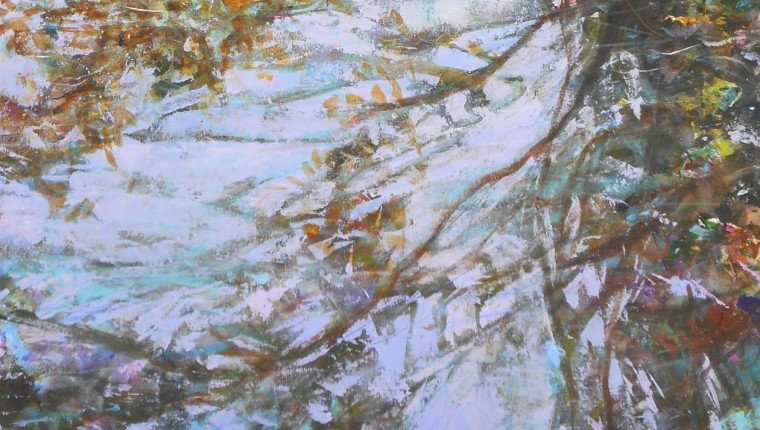By Yuly Restrepo
An Afternoon at the 2021 Arts Annual
. . .
Through December 19
Creative Pinellas Gallery
Details here
. . .
Visiting this year’s Arts Annual feels like a gift at a moment when the upheaval of COVID-19 seems endless.
And though some of the work, such as Jim Gigurtsis’ tryptic, 2020, which depicts a human figure seated in a chair in various emotional states at different stages of home confinement, reminds the audience of that upheaval, one cannot help but feel thankful for the tenacity of artists and the art they produced during this period.
. . .
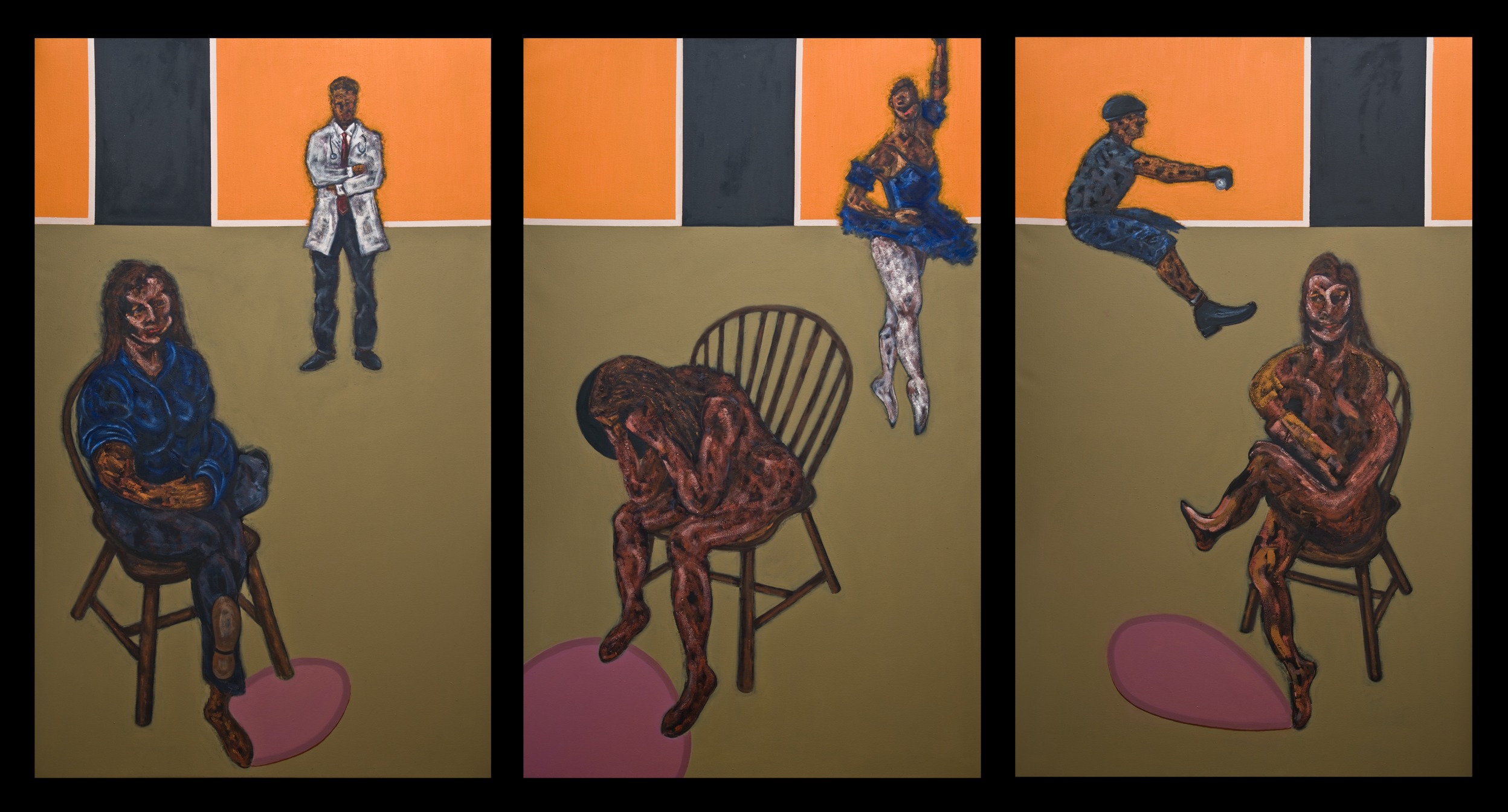
. . .
That art is an impressive display at the Creative Pinellas Gallery, which welcomes the public through December 19, with the best work our local visual artists have to offer.
I visited on a quiet, overcast Sunday afternoon, which put me in a contemplative mood that felt just right to absorb the richness around me. The work is too abundant to cover here in its entirety, but the overall highlight for me was the real diversity in technique, scale, trajectory and subject that all the artists brought to the front.
. . .

. . .
One of the first works that encouraged me to pay close attention was Gabriel Ramos’s line work duo, Memorias Enredadas, which quickly put me in a meditative state as I followed its almost totally uninterrupted line depicting continually emerging cityscapes, as if the artist’s memories are a continuous line, forming the trajectory of an entire life.

. . .
My favorite sculptural work was that of Christina Bertsos, whose abstract Love puts us in mind of a figure intertwining upon itself, with itself. That, along with Aphrodite Rising, which presents the torso of the mythical goddess emerging from marble, is both smooth and angular, solid and shimmering.
. . .
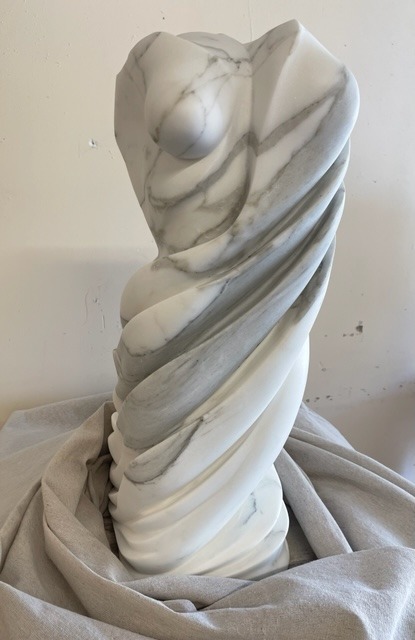
. . .
I also admired mixed media pieces, such as Ari Robinson’s Controlled Chaos, one of many works that embraced vibrant colors and patterns contained in smooth fluid shapes, “like rolling hills or waves.”
. . .
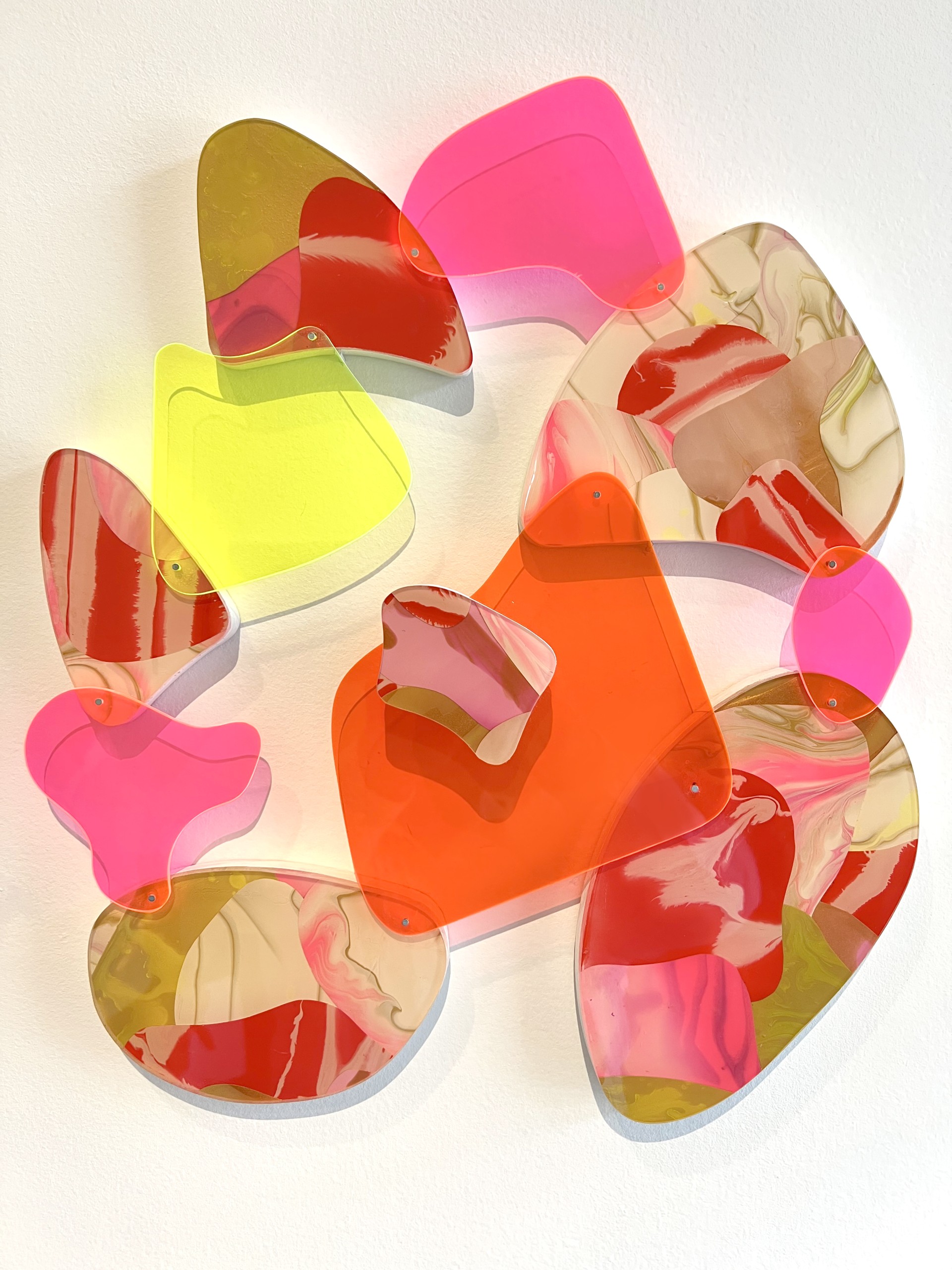

. . .
A couple of other artists exploring two-dimensional work are Judy Vienneau, whose Isolation series depicts scenes of people confined to their homes during the COVID-19 crisis. These are made of wire, newspaper and other materials, and in turn portray a person singing opera, playing the violin, or gardening through a window. The figures are made of wire that pops out of each window, making them vivid as portraits of hope at a time of so much death.
. . .

. . .
I was also struck by the work of Zoe Papas, whose charcoal drawings, while having a very classical appearance, incorporate a sense of dimension using cutouts within the frame, which places them right at home with other contemporary works in the exhibit.
. . .
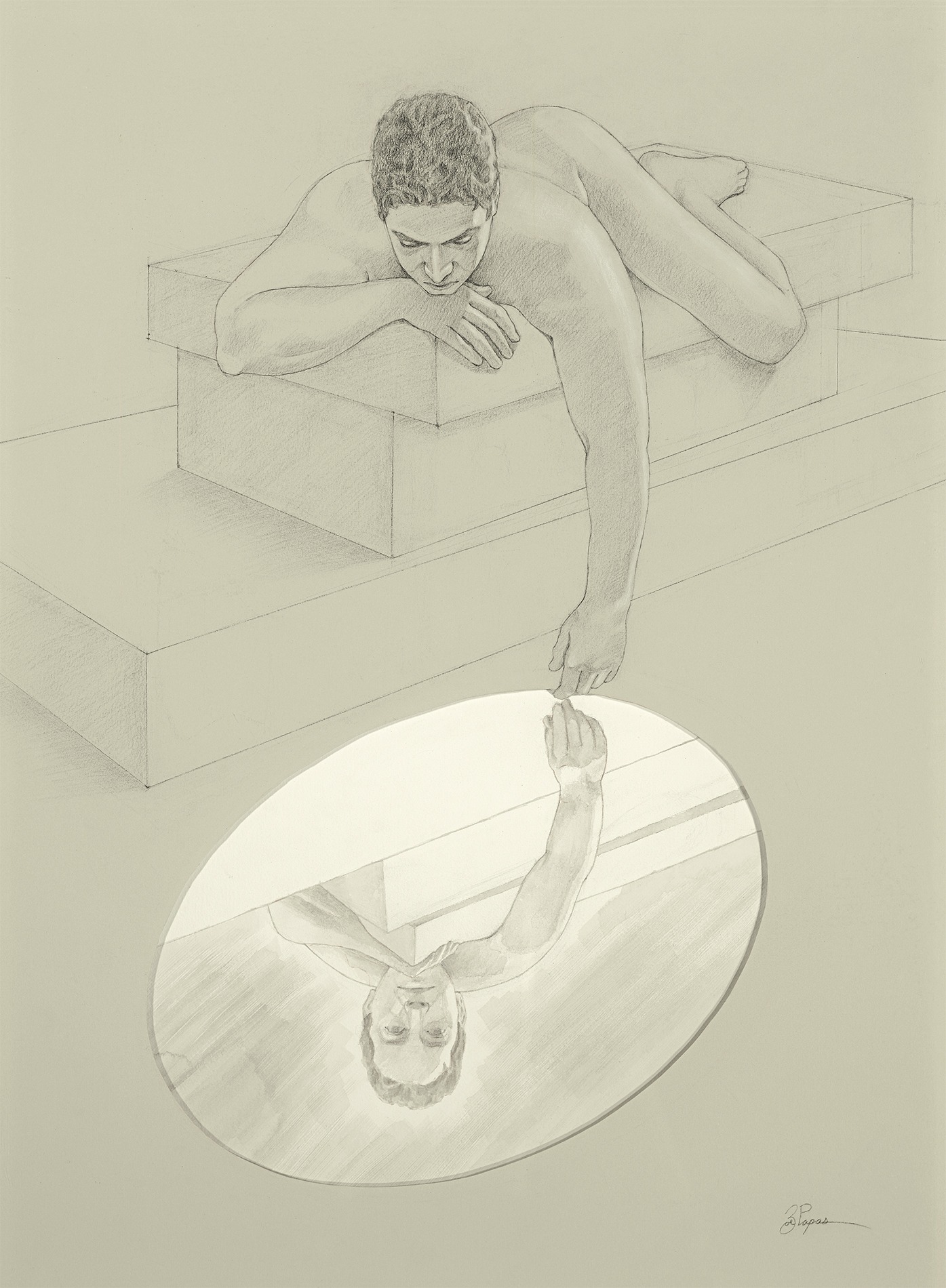

. . .
When it comes to painting, I’m ultimately attracted to the use of bright, saturated color – and in this regard, the Arts Annual doesn’t remotely disappoint. One of the beautiful things about having such a high number of artists in the same exhibition is that one is likely to see so many possibilities, whether in technique or scale, subject or use of color.
. . .
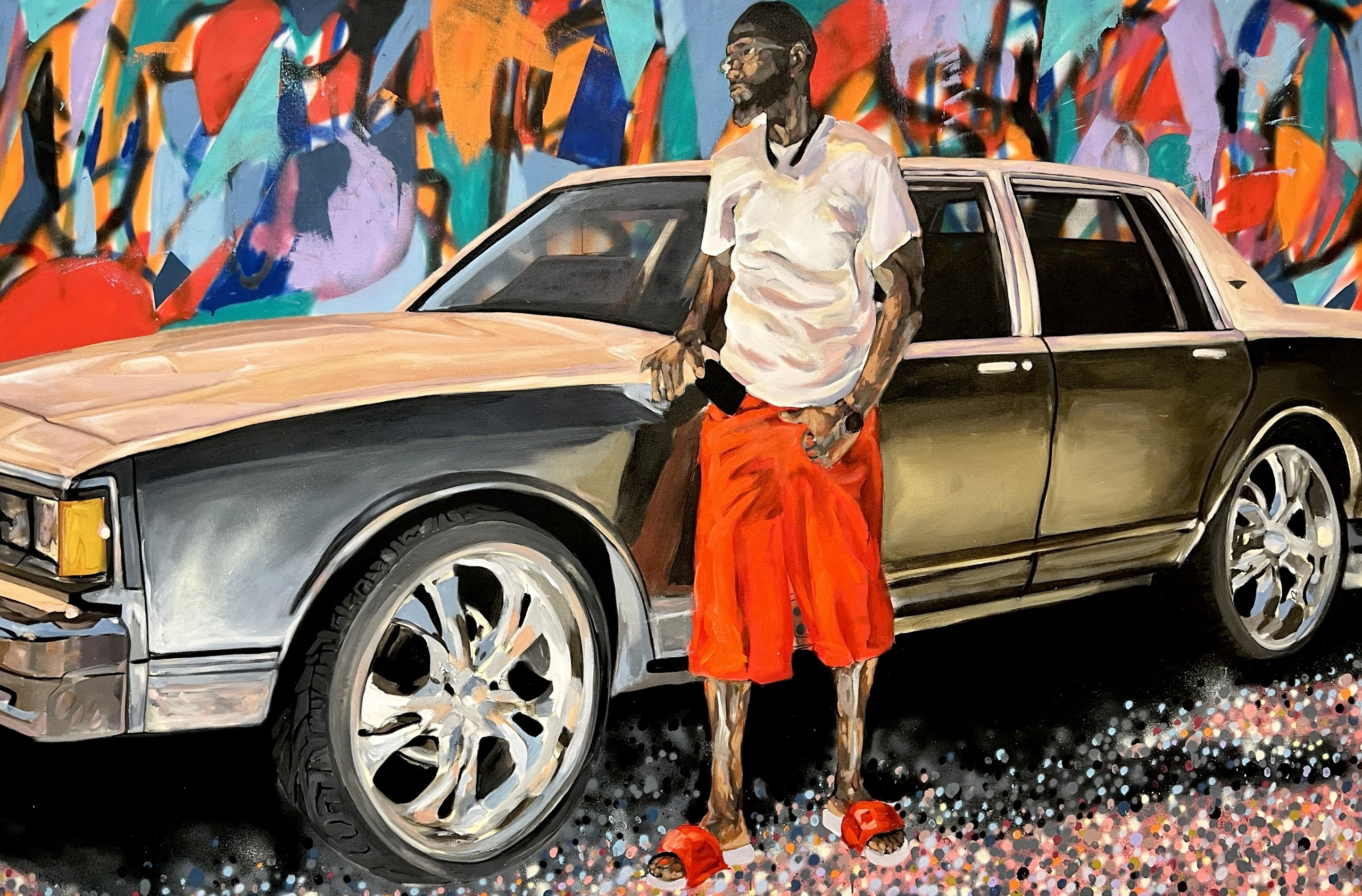
. . .
One of the most eye-popping paintings in the exhibit is Reid Jenkins’s Mizzle and Barbie, an enormous piece that depicts a man standing in front of a boxy car, with a hand in his pocket. Though the car is gray, the painting explodes through the man’s bright red shorts and sandals, and the way they echo the bright graffiti on the wall behind the car. It’s an everyday scene that becomes transcendent through the artist’s regard of its subject.
. . .
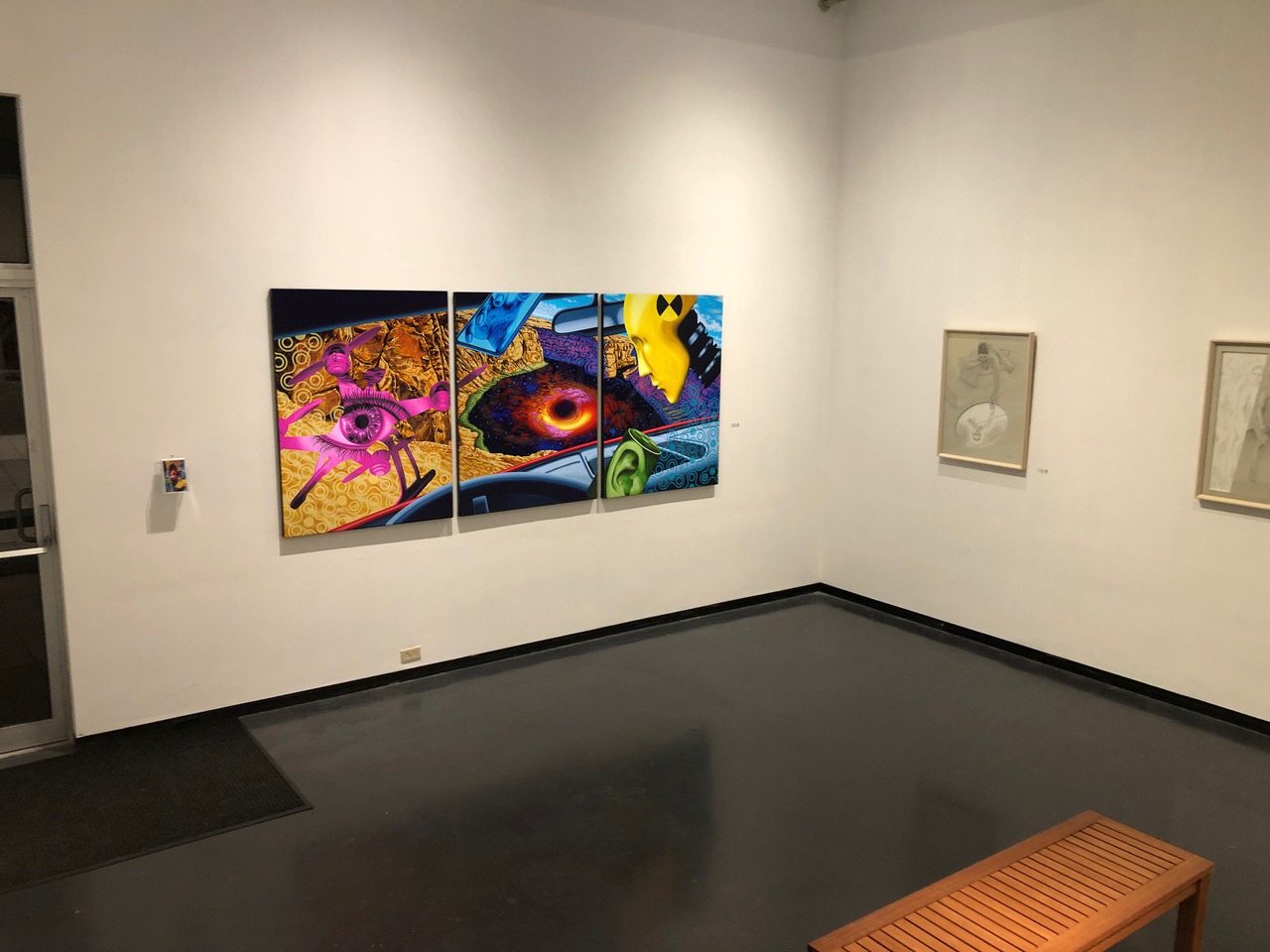
. . .
Also striking is Mark Mitchell’s large-scale triptych, Distracted Driving, a dreamlike depiction of a crash-test dummy driving a car into what seems like the oblivion of a black hole. Around the dummy are everyday distractions like a drone, a cellphone and fidget spinners, all of which seem to be hurtling into the blackness.
. . .
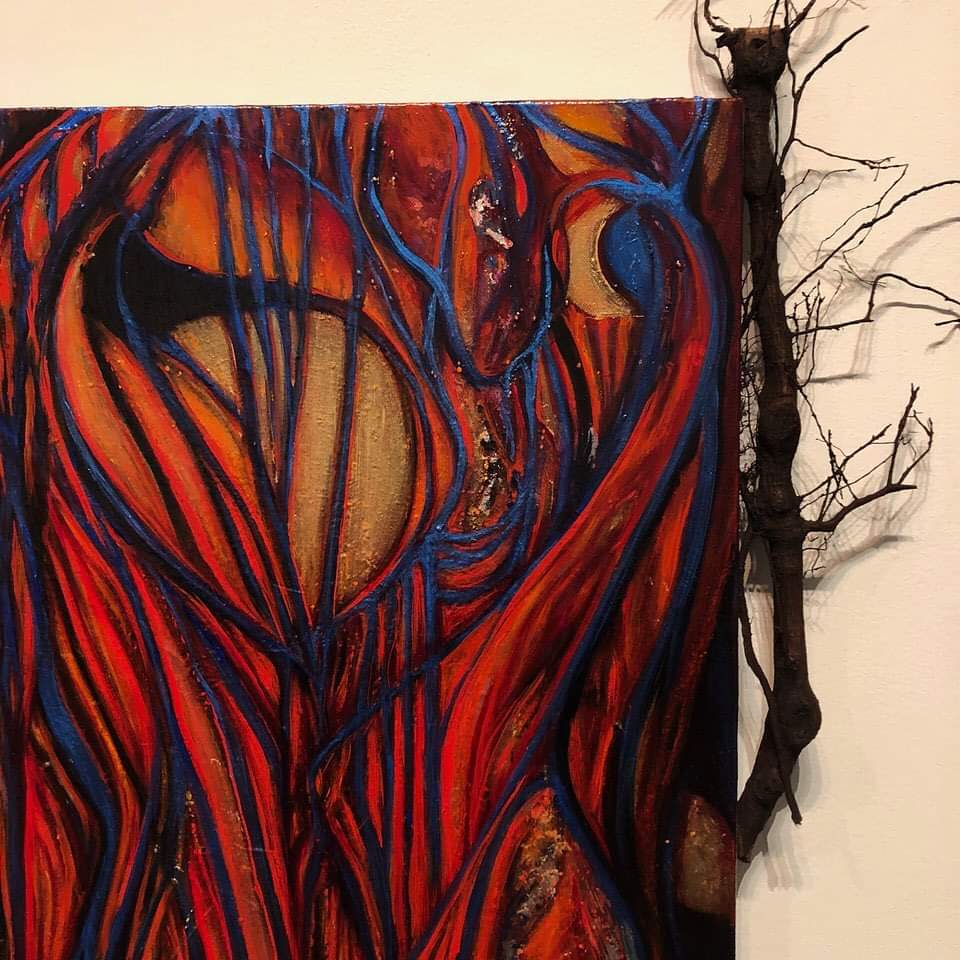
. . .
I also enjoyed D YaeL Kelley’s intense Rootwork: Ecstatic Dances, whose strong brushstrokes of tense red and blue lines, and the tree branches that extend those brushstrokes outside the frame of each painting, made me feel like I was quite literally inside the human body. Likewise, I was pulled in by Kevin Grass’s playful and uncanny small-scale paintings of bright yellow rubber ducks talking on the phone, graduating as valedictorian and floating in a mug of milk.
. . .
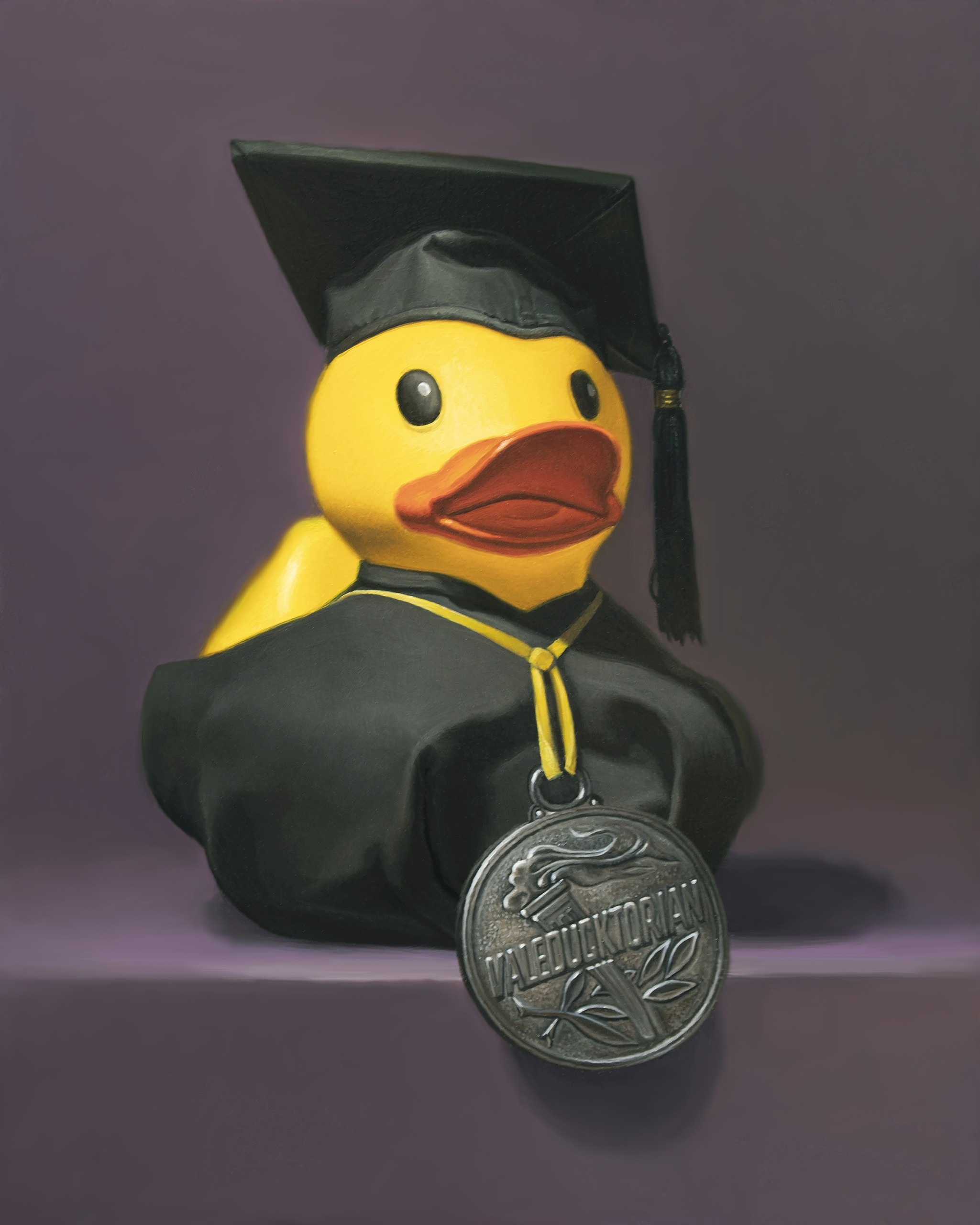
. . .
Finally, I was utterly transported into the dream world of Linda Costa’s long-exposure photographs, whose lighting techniques give the constant impression of magic and motion within a still frame. These photographs, in particular Shiva and Kali, shimmer with hot pinks and purples, and many-armed, joyous figures surrounded by lines of light. They aren’t so much the specter of joy as joy in movement.
. . .
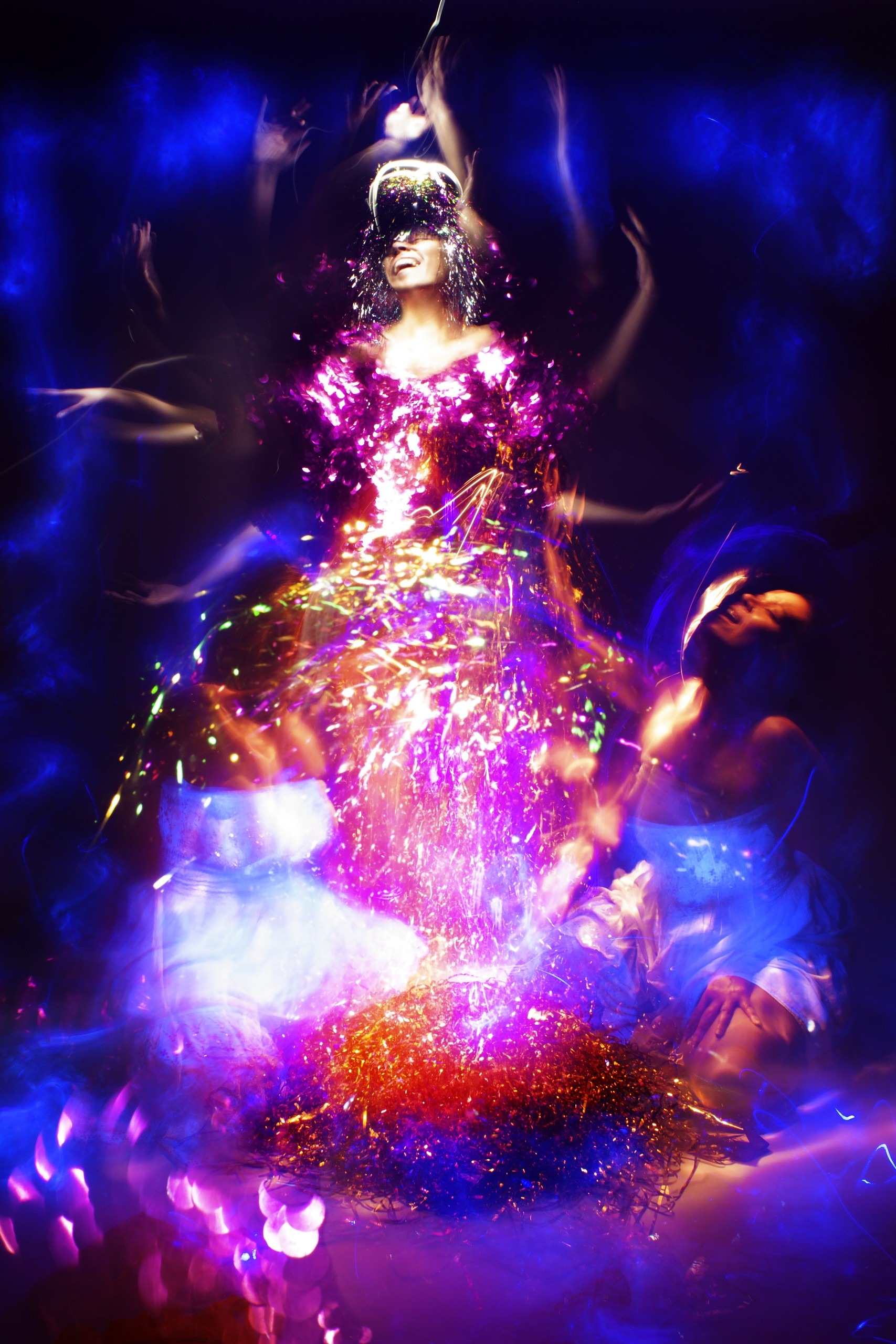
. . .
After witnessing Costa’s work, I left the gallery feeling afloat from all the powerful art I had witnessed. I was buoyant with the knowledge that, even in the most difficult and isolating of times, artists will continue to create and question and cling to the world’s beauty.
The 2021 Arts Annual
in these Artists’ Own Words
. . .
Elizabeth Barenis
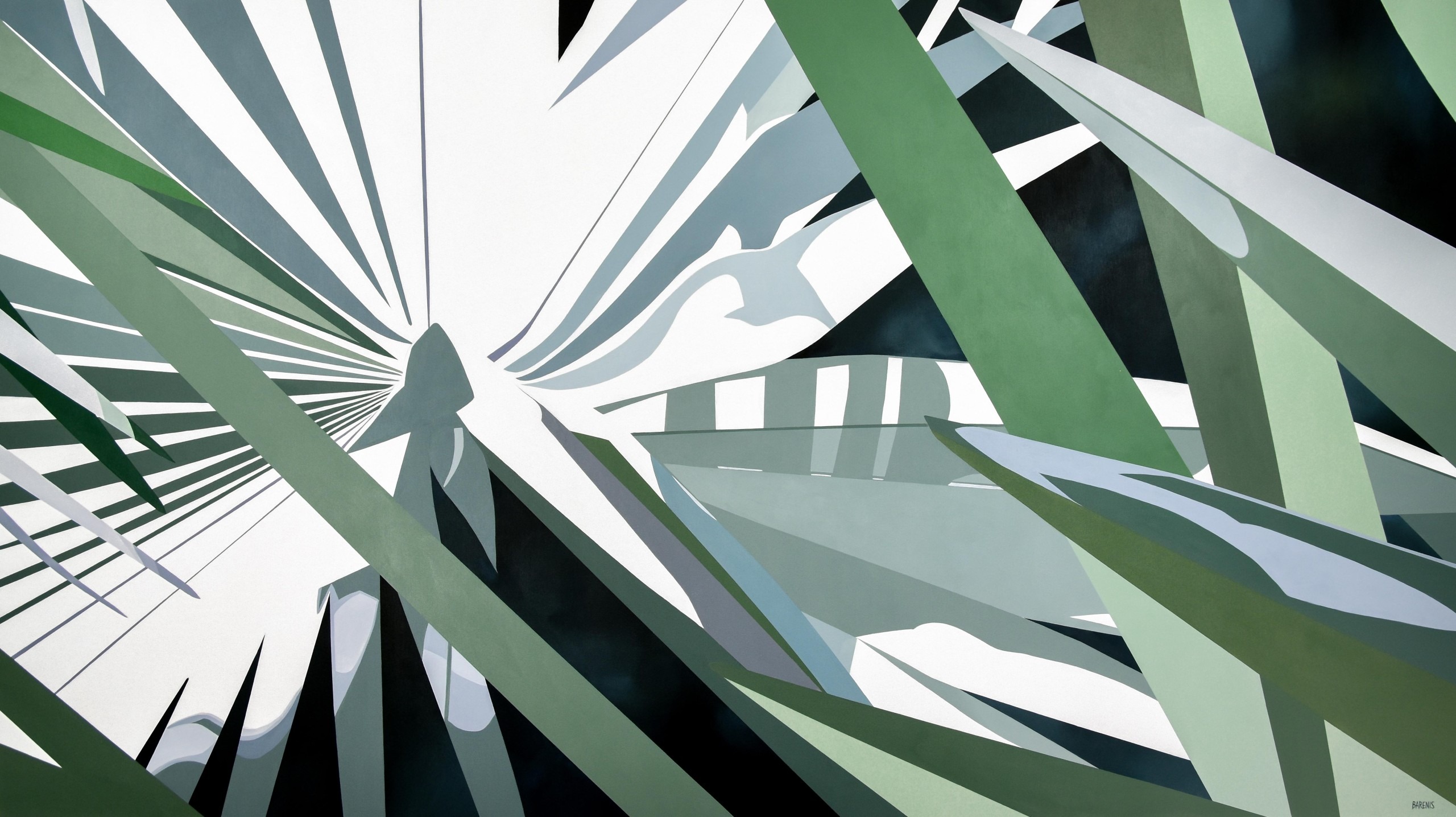
At first glance, one might say my painting celebrates palm trees and living in Florida. But further observation reveals that A Sign of Something Greater has a deeper meaning.If you study the palm fronds in the painting and compare their position to the shadows cast, you will notice that there are some shadows present of which there is no apparent source. In this way, the viewer discovers there is more to the picture than what is presently perceivable.Further, I believe the human experience of beauty, of feeling awe, hints at a force greater than earthly existence. And when we can recognize beauty and sustain that feeling of awe – which my work seeks to accomplish – a divine order can manifest to create harmony in our lives.Creative Pinellas continues to inspire and motivate me to keep creating and evolving. The opportunity to exhibit in such a beautiful gallery space at the Arts Annual was the impetus for taking on my largest, single canvas work to date.
. . .
Nathan Beard

. . .
I find inspiration for my Pond’s Edge paintings and drawings at the shoreline of many of our region’s most serene waterways.
For these newest paintings, my muse lay in the canals of Dunedin’s Hammock Park, and in the creek named Cedar that feeds a freshwater yin the park’s brackish Tao.
. . .

. . .
These paintings are special because they started as demonstrations for students in my popular Saturday morning class at Dunedin Fine Art Center called “Wetland to Studio.” Teaching forces me to walk-the-walk and incorporate many techniques normally reserved for abstract painting, but in my class this is utilized for the interpretation of nature and its energies, rather than mere transcription.
Moving forward into the next year, I am very excited about a new program I am offering (directly to clients and to the design trade), where I will travel to one’s favorite shoreline to take in the Land’s spirit and gather reference photos for a very special and personal commission for home or office. So far, I’ve completed one drawing commission for a local Florida family, and am in the process of completing commissions based on waters in Maine and Colorado, with Georgia on the horizon.
Christina Bertsos

. . .
Aphrodite Rising was born out of a deep sense of wanting to honor my Hellenic heritage as well as the strong feminine energy that this goddess represents.
Often depicted for her sensual qualities, I wanted to show her strength.
. . .
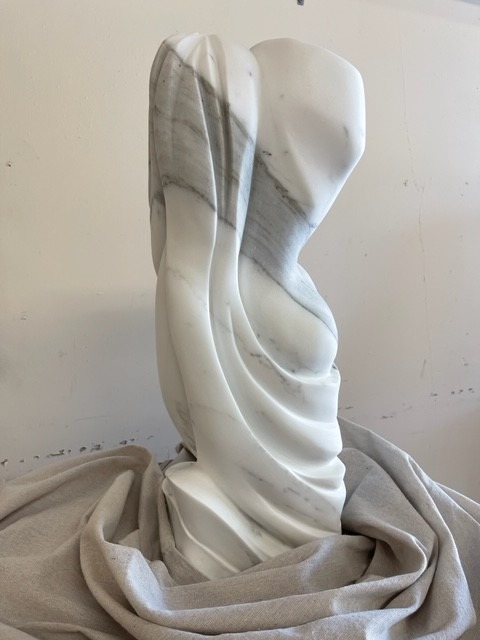
. . .
I also wanted it to seem as if she is in the process of becoming as we all are, in our desire to be more and to realize our perfection in every instance. Our continual evolution toward our highest state as a human being.
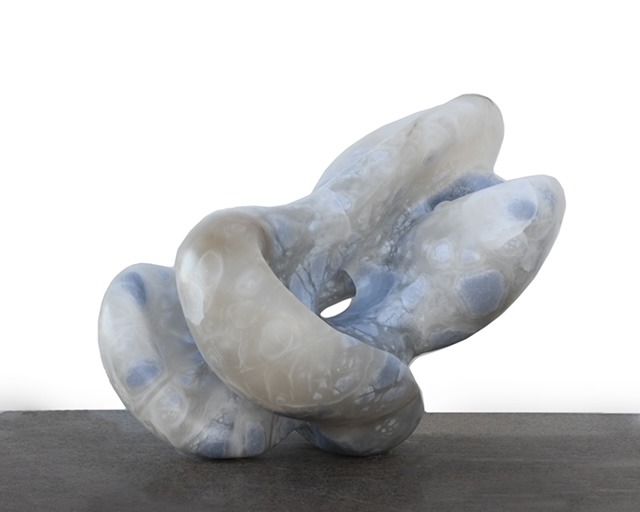
. . .
I am a direct stone sculptor which means I let the stone guide me as to the shape it ultimately takes. And that process fuses with everything I have accumulated in thought and experience up to that moment in time.
Often I am surprised by the outcome but it always makes sense from a personal standpoint.
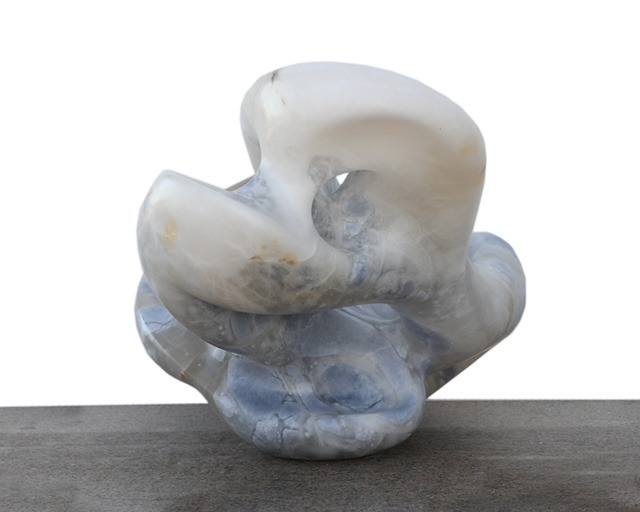
. . .
As I was carving Love and began to notice the intricate colors within the stone, I felt that I had to go deeper into it to discover and reveal its beauty. The more I did this the more I discovered and the more it shared with me.
Like Love we have to allow it to take us, its power being so immense. It is the essence of who we are.
I left some original scars on the stone to symbolize our fragile nature as humans as we embark on the journey to discover that Love.
. . .
Saumitra Chandratreya
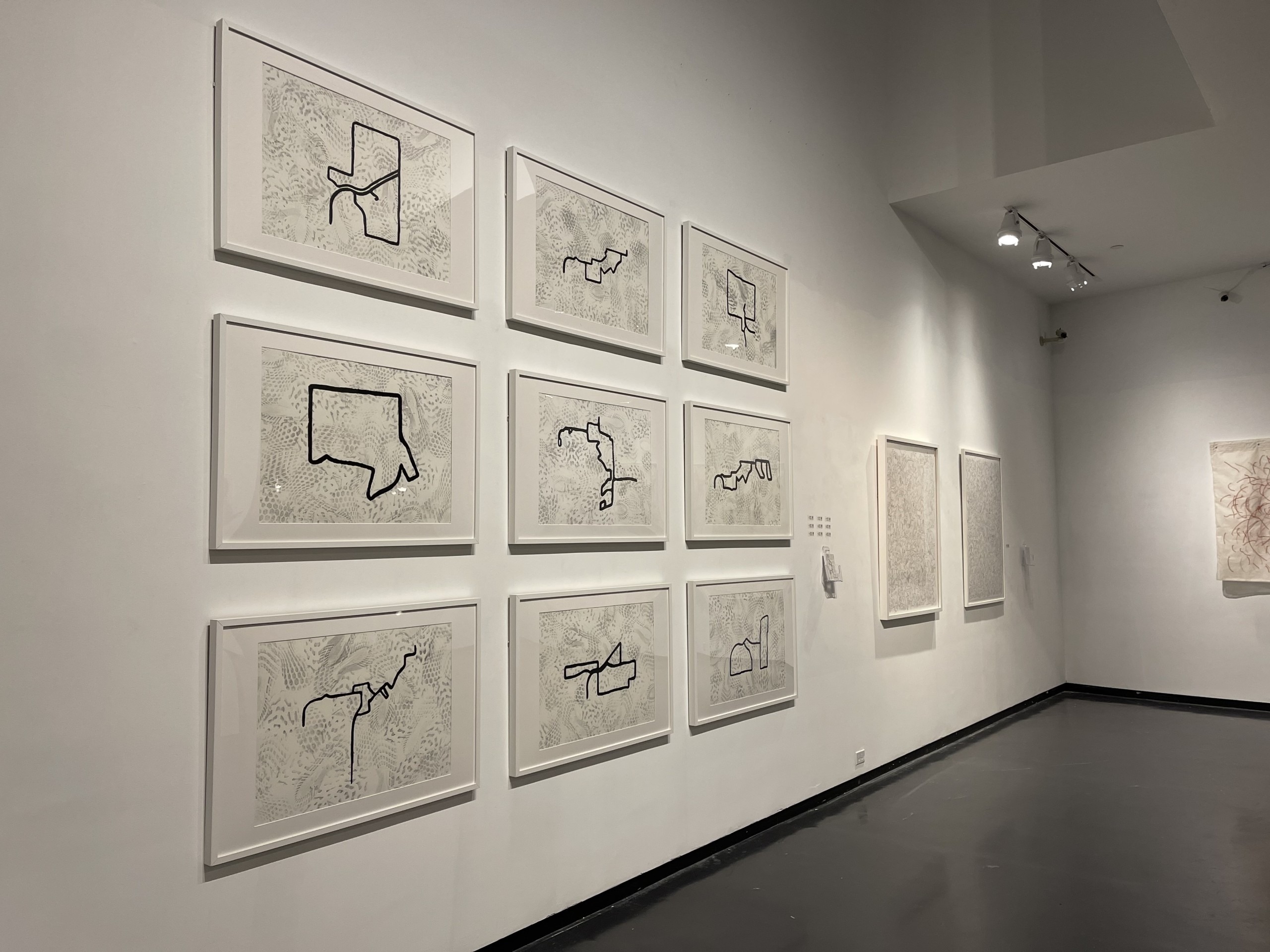
. . .
The series is titled Run Saumi Run – the pieces are installed in the gallery in a grid form to emulate a grid of city streets.
. . .

. . .
The pieces are framed hand pulled silk screen prints of the maps of my runs around my neighborhood in South St. Pete. I wanted to show how I see my neighborhood as this collection of lines and shapes I form consciously or unconsciously when I run.
. . .
. . .
Linda Costa
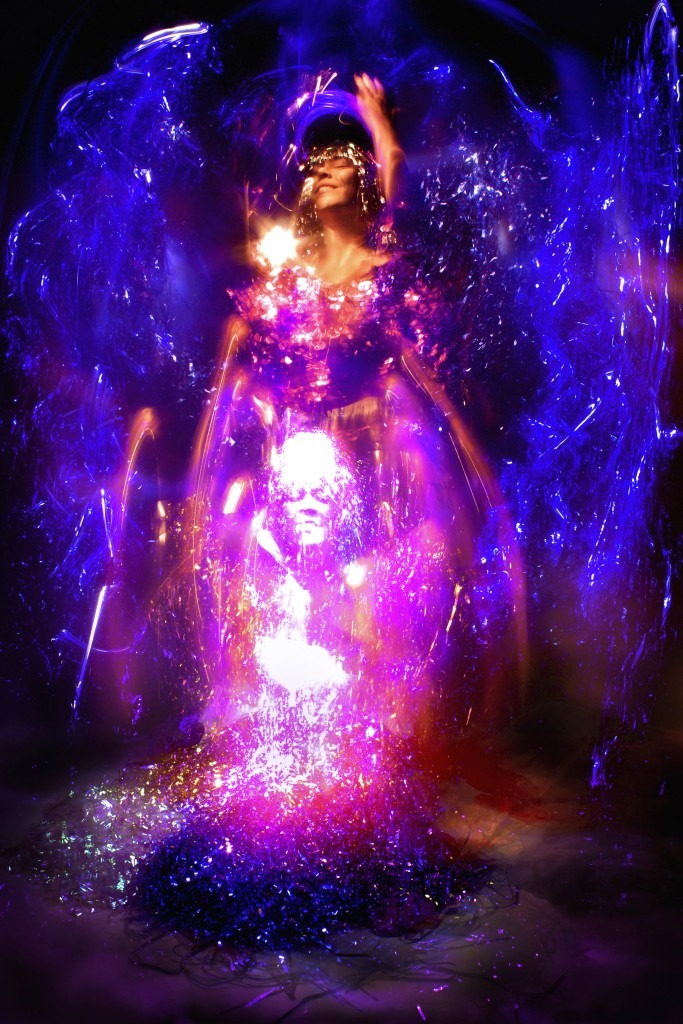
. . .
I created these images for my Rituals of Self Love series in 2019 when I received a Creative Pinellas Emerging Artist grant. I was partnered with the phenomenal photographer and professor Selina Roman as my mentor. We shared a love of color, texture and shine that was exciting to explore together.
She invited me to shoot some images I had described in her studio and provided me space, a paper drop background – and showed me her collection of sequin outfits, shiny wigs and tinsel curtains.
I had worked with tinsel for effects in my light paintings for years, but I had used a small Ziploc bag’s worth in my hand to light around the subject and had not expanded further. I’m so grateful for her support and inspiration.
This shoot was my first experience with large bundles of tinsel, which is the textured blue in the background and the glowing ‘skirt’ bon fire below me in these self portraits. I’ve since included tinsel in my work, and as part of my most recent installation works for Creative Pinellas.
The titles of the works Shiva and Kali refer to personal rituals of liberation where I had a deep connection with each of the archetypes of these Hindu deities as ways of loving myself as I am, as well as understanding my higher self. In my own intimate way I was inspired by their energies in spiritual and creative rituals that helped me come to terms with ideas of sensuality, healing, freedom, surrender, release, oneness – and through that, to connect deeply with my own personal power.
. . .
Neverne Covington
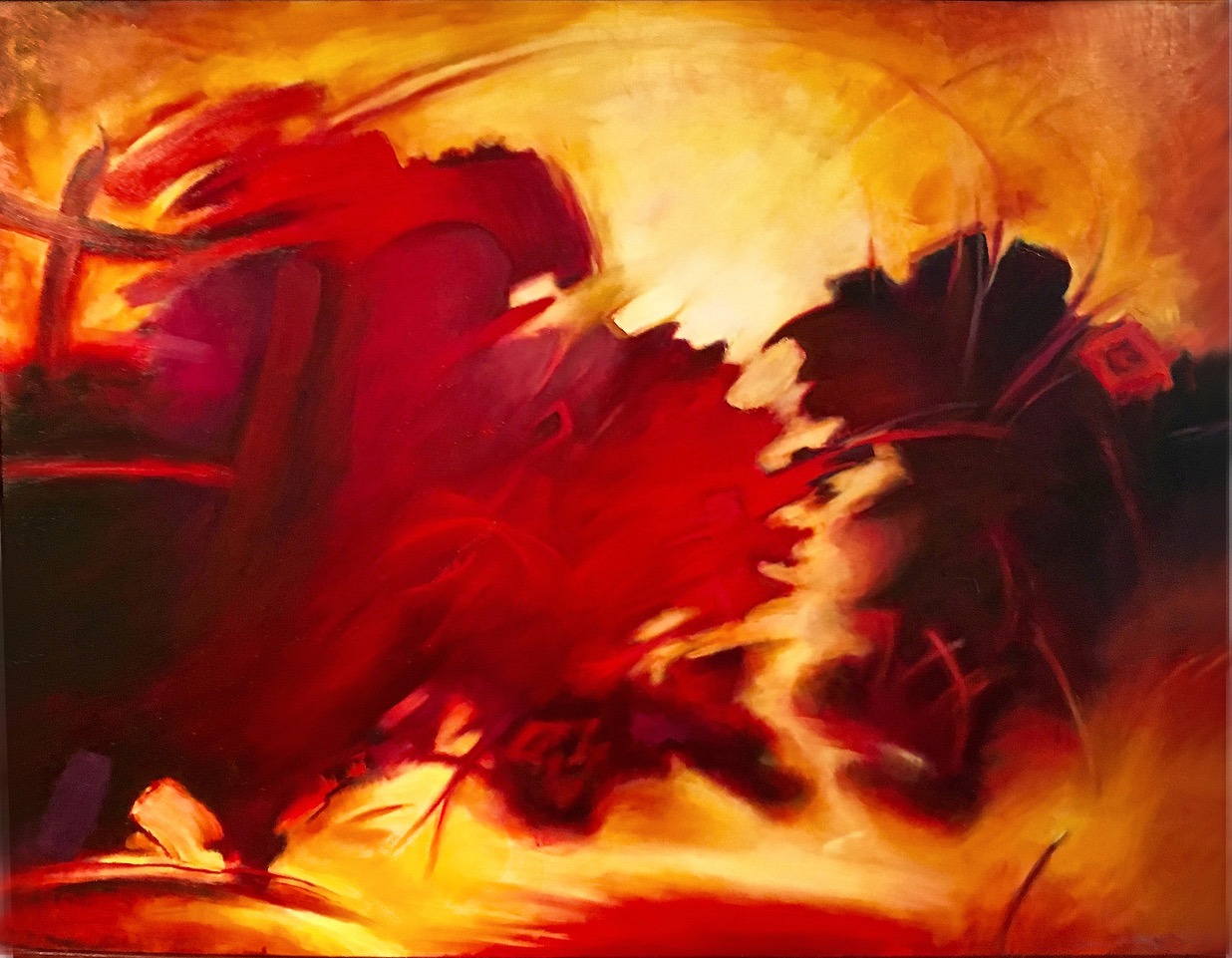
. . .
I have drawn and painted since childhood. Growing up in the South, with its resplendent light and verdant landscape, botanical diversity has been an endless source of inspiration for my work.
My imagery is inspired by direct observation and memory influenced by the richness and light of our region. My work combines abstraction and figuration addressing the flow of time and movement and the rhythm of nature, which brims with mystery and intrigue. It is lush, dense and complete.
. . .
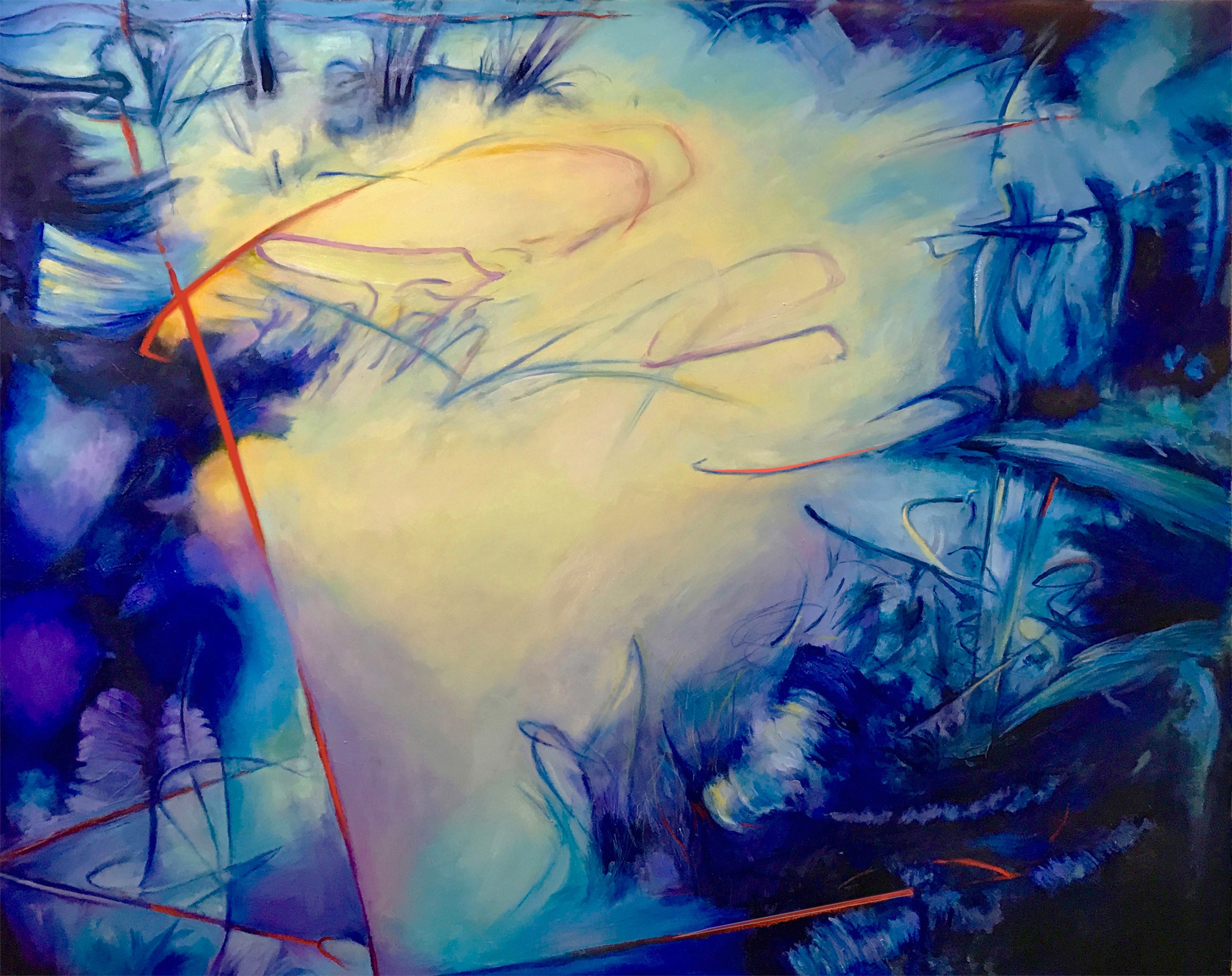
. . .
The primal, tangible and intangible forces that form matter, from which our being, our very nature, emerges. . . it is this which interests me most. I am fascinated with what was here before, what lives and breathes now, with humankind’s relationship to matter. . . The being of nature. This fills me with awe and wonder.
Much of the time, I don’t know what my paintings are about until after I finish them, emerging, I suspect from the subconscious, they sometimes reveal their content through form.
. . .
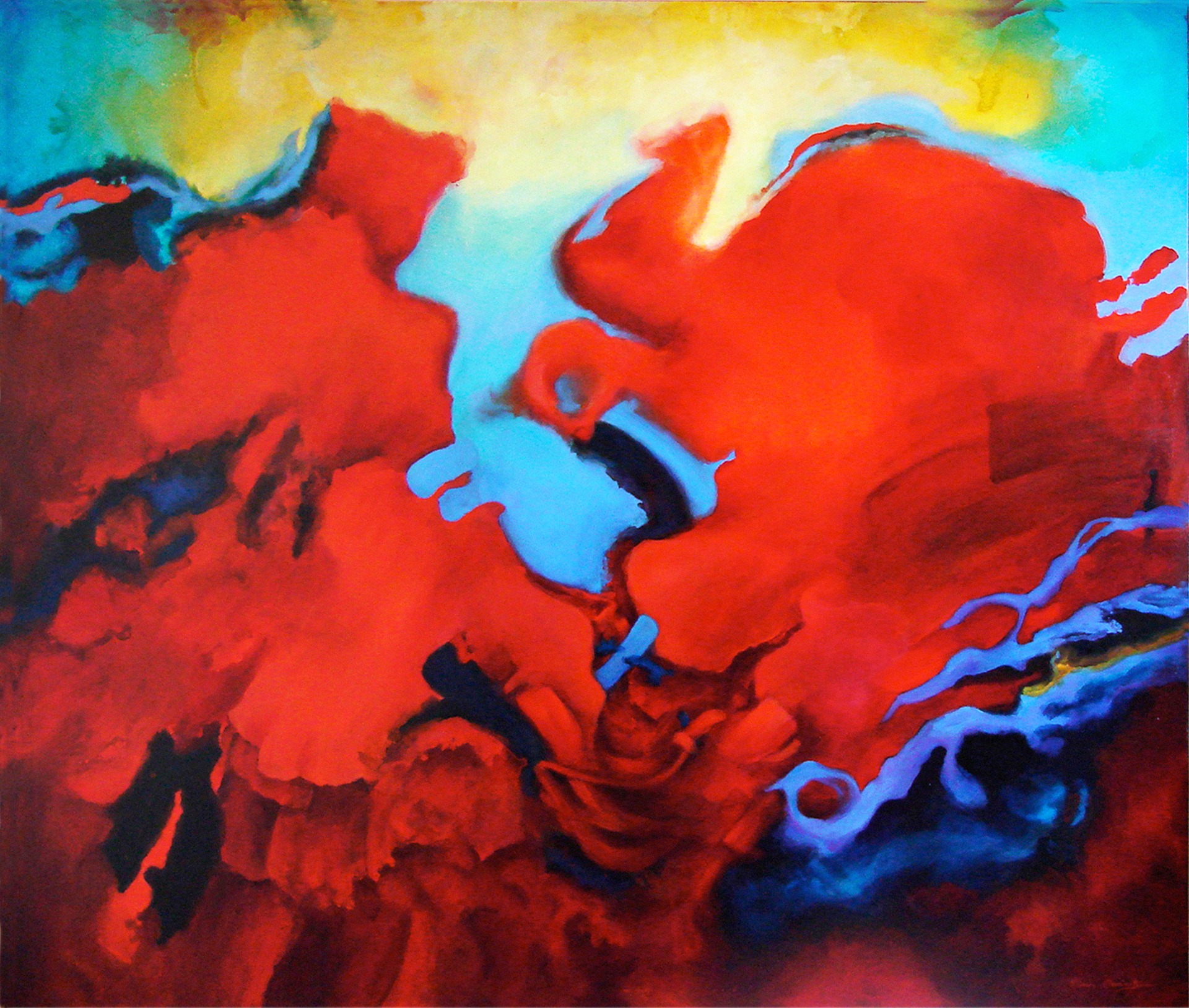
. . .
The works shown here are informed by a keen interest in Buddhism and the nature of change. My work is rooted in the belief that everything in life is impermanent and always changing. Into the Blue is inspired by a hexagram from the I-Ching titled Feng, or abundance. State of Flux reflects the concept of impermanence and Red Delicious, the sheer gratitude of being alive.
. . .
You can read an interview with Neverne Covington
in the Tampa Review and explore her YouTube channel
. . .
Creative Clay
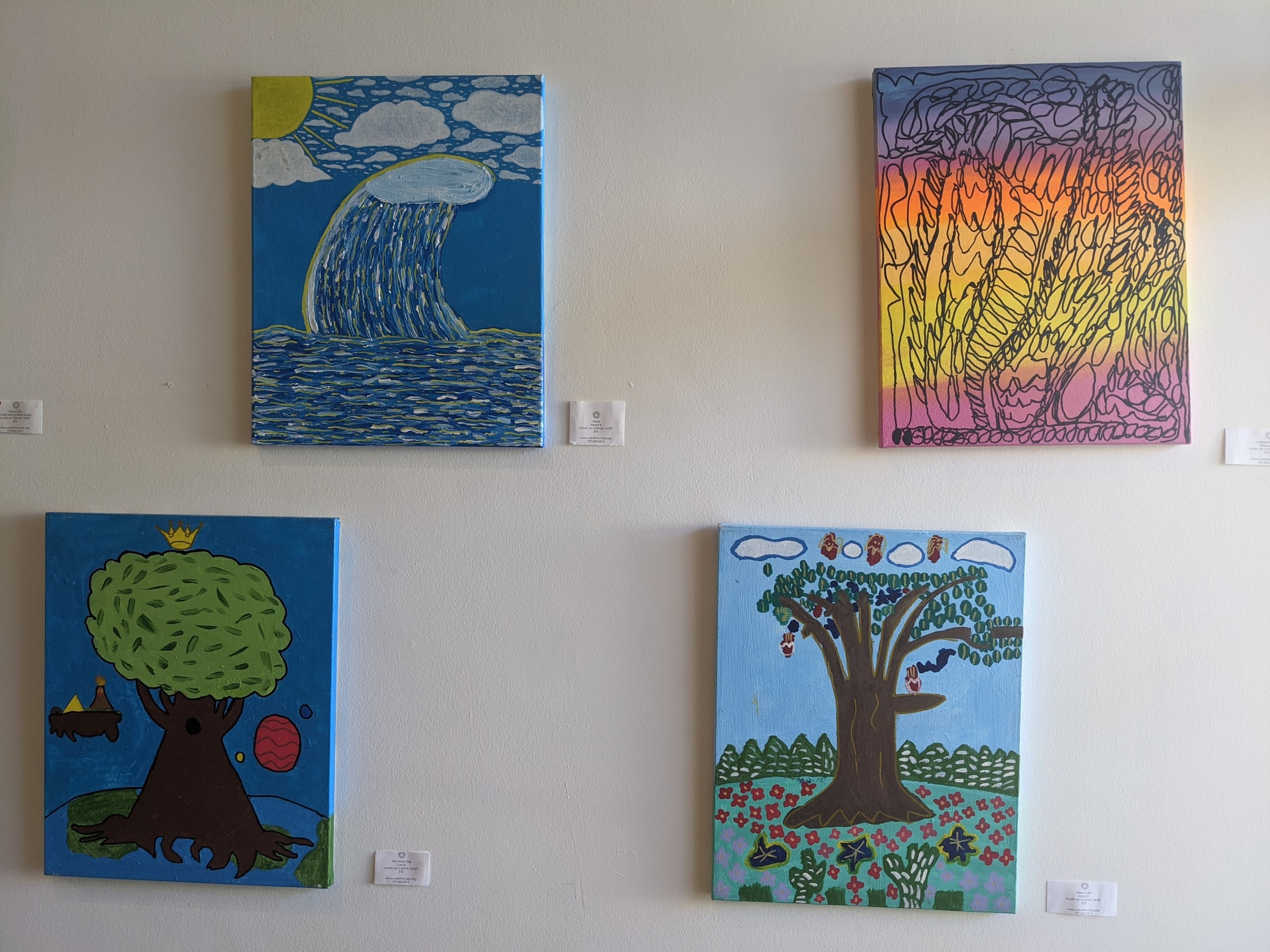
. . .
The artists of Creative Clay are often part of playwright Sheila Cowley and choreographer Paula Kramer’s Sparks Collaborative Ensemble. This year, Creative Clay’s Transition Students worked with Kramer to create dances and visual art inspired by Cowley’s short play, Sparks in the Rain.
. . .
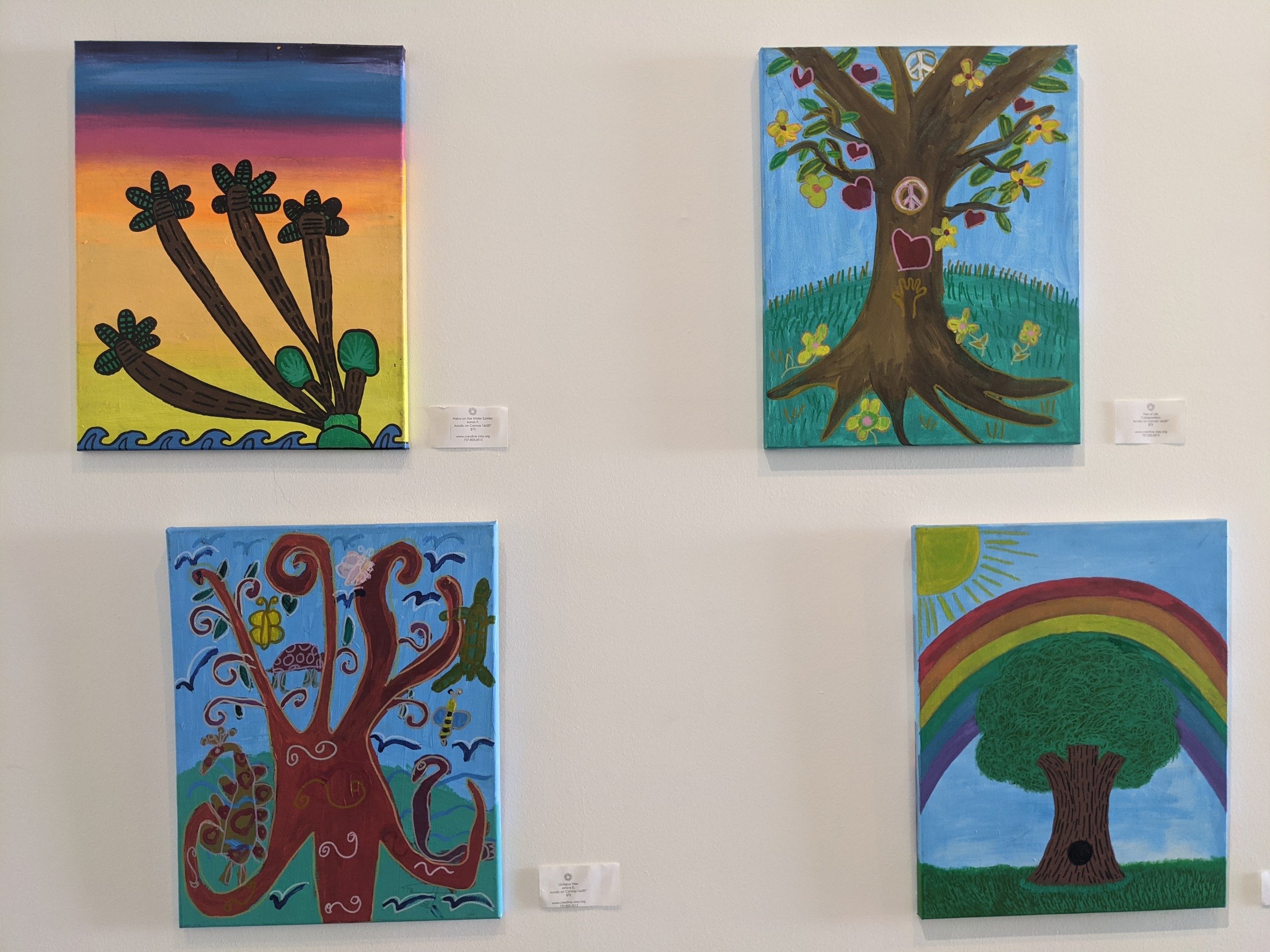
. . .
These paintings were inspired by the words and images in the script – and several were featured on the set of a live performance by Creative Pinellas Artist Laureate Helen Hansen French with dancer Fernando Chonqui, actor K Chinthana Sotakoun and ukulele player Emily Stehle during Arts Annual Weekend.
. . .
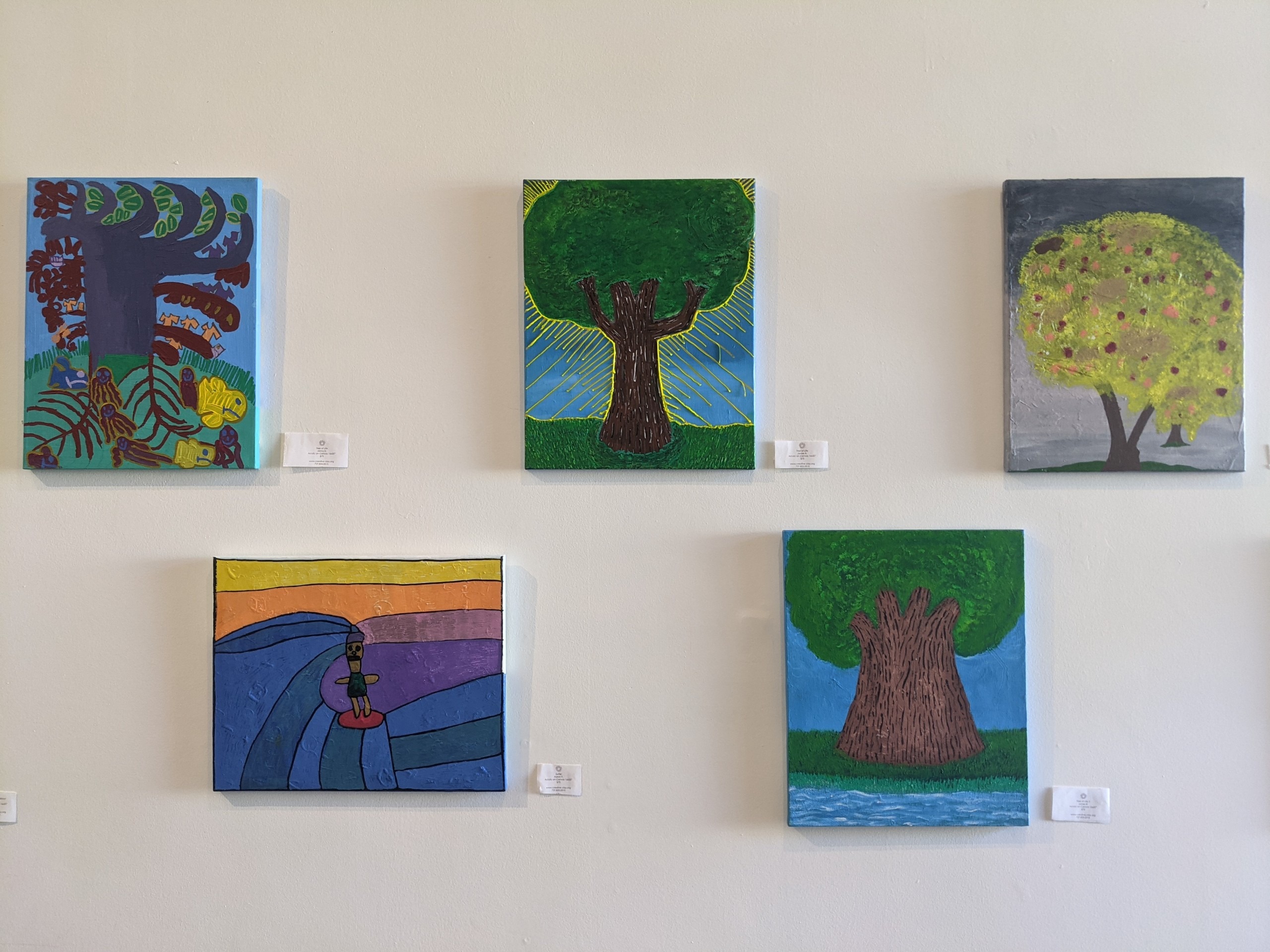
. . .
Creative Clay’s mission is to help people with disabilities achieve full and inclusive lives by providing expressive, educational and vocational experiences in the arts.
. . .
Lynn Foskett
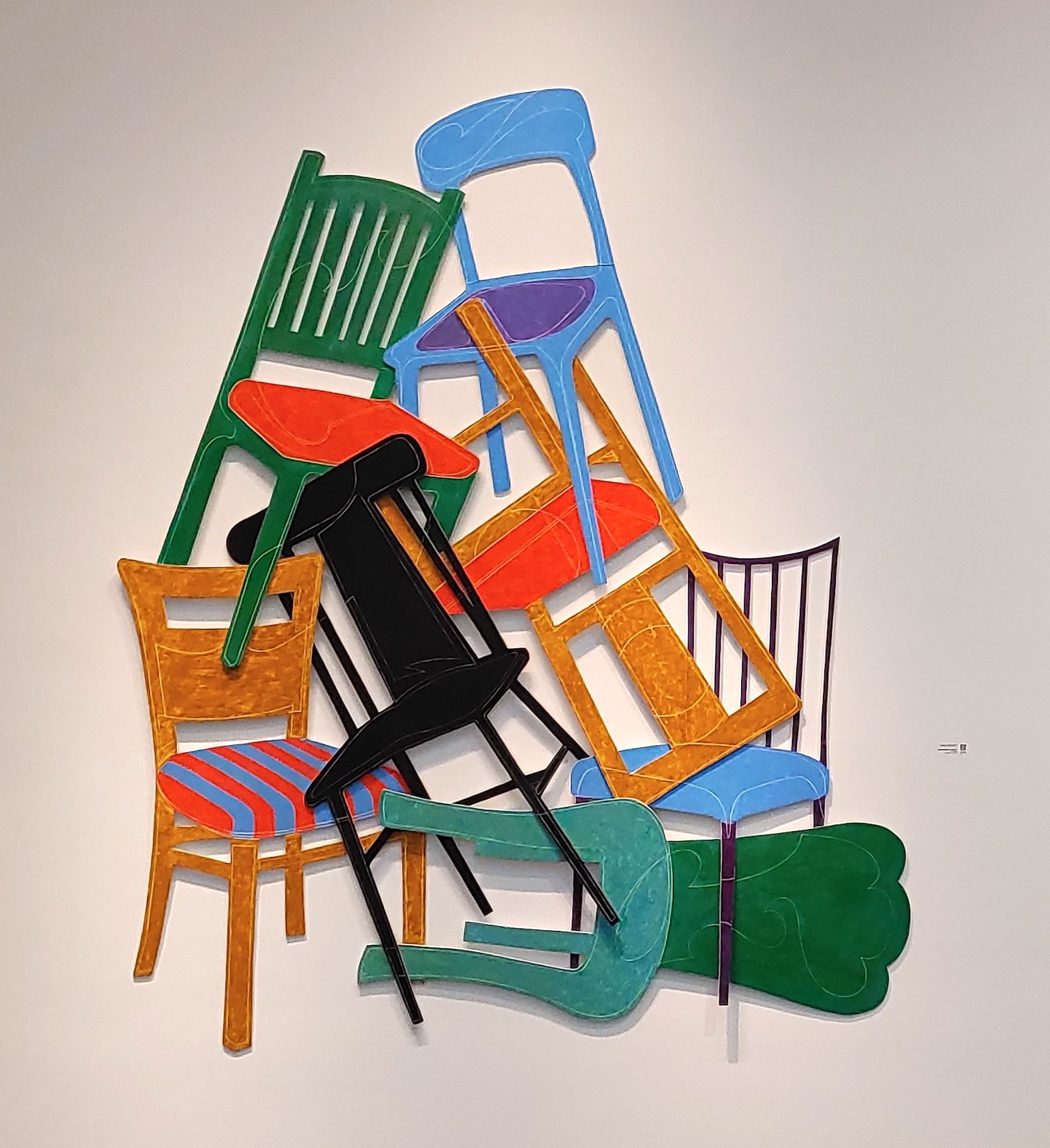
. . .
As An Illusion of Stability was coming together, it took me back to a childhood memory of having wandered into an immense, old barn packed with discarded furniture.
As my eyes adjusted to the gloom I looked up to find myself facing a two-story stack of wooden chairs – every type and size thrown on top of each other, chairs locked into chairs with legs and arms sticking out at all angles, and the light and dust from the hayloft opening filtering down through them.
I was mesmerized.
. . .
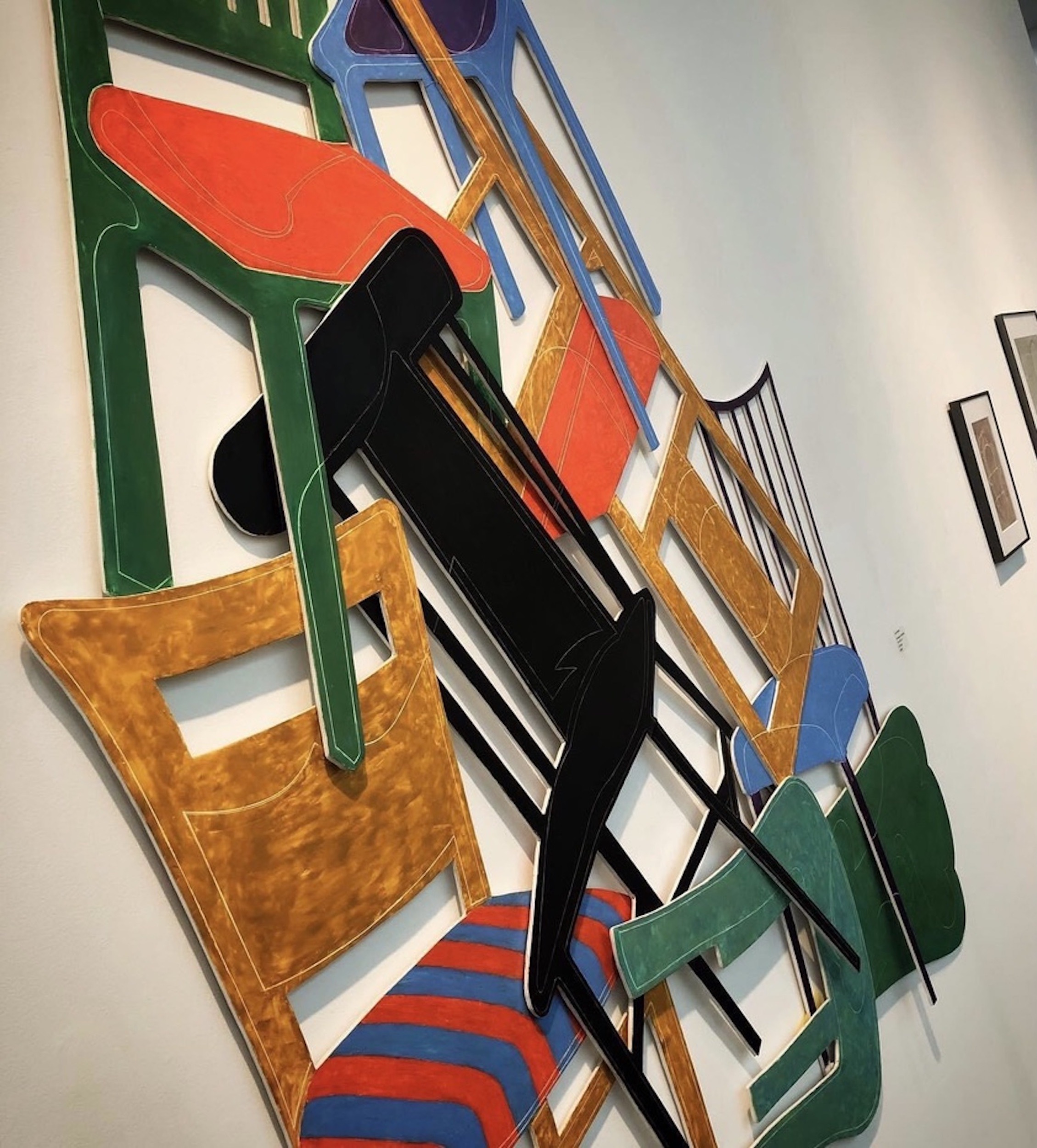
. . .
Don Gialanella
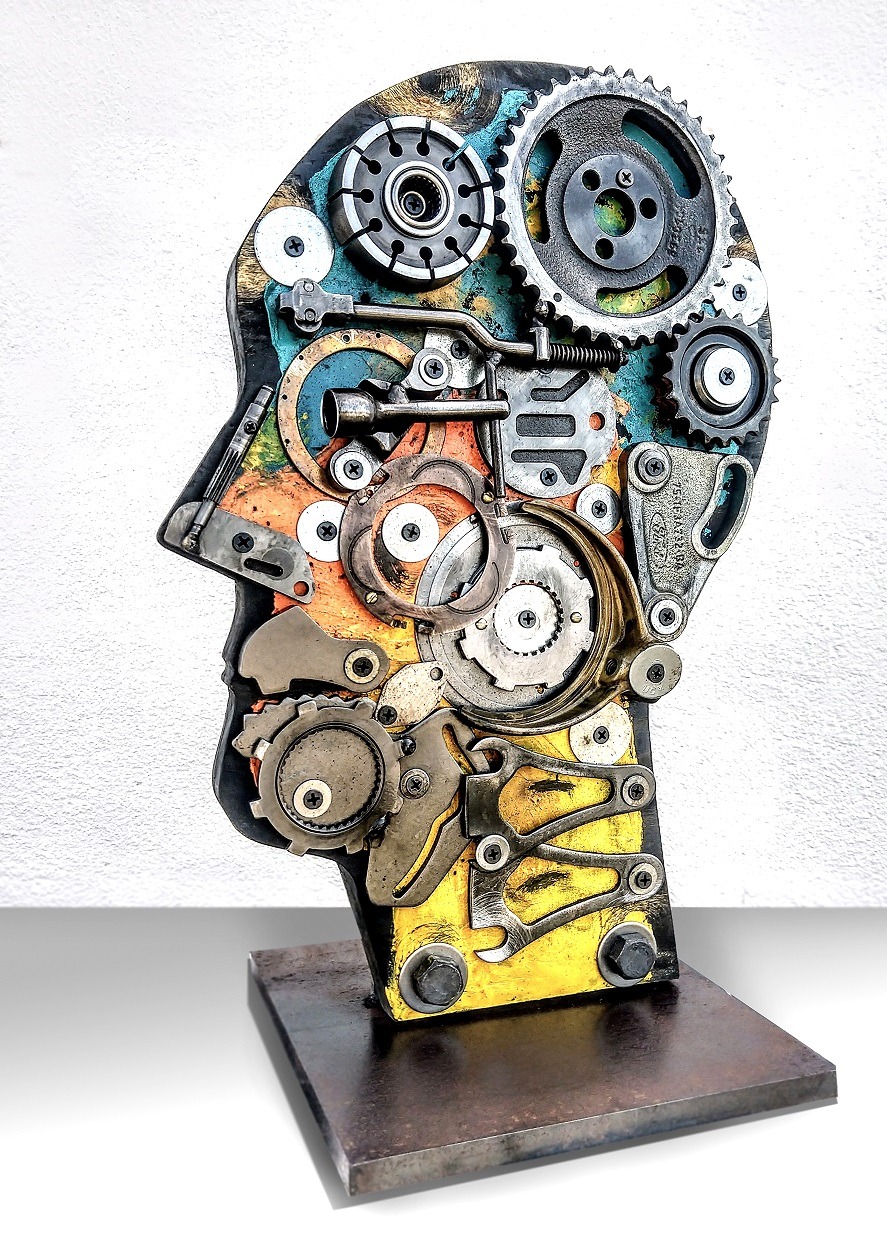
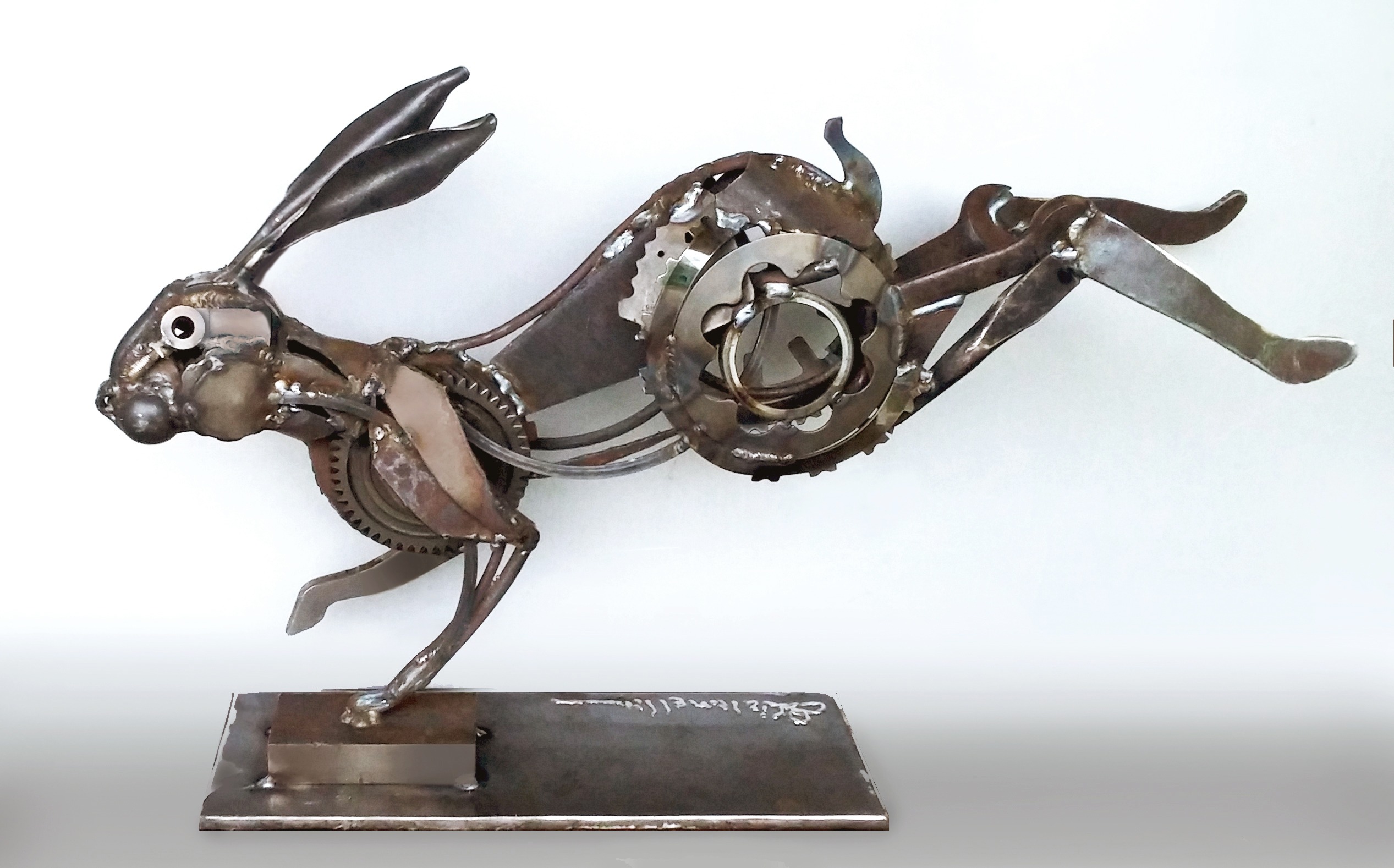
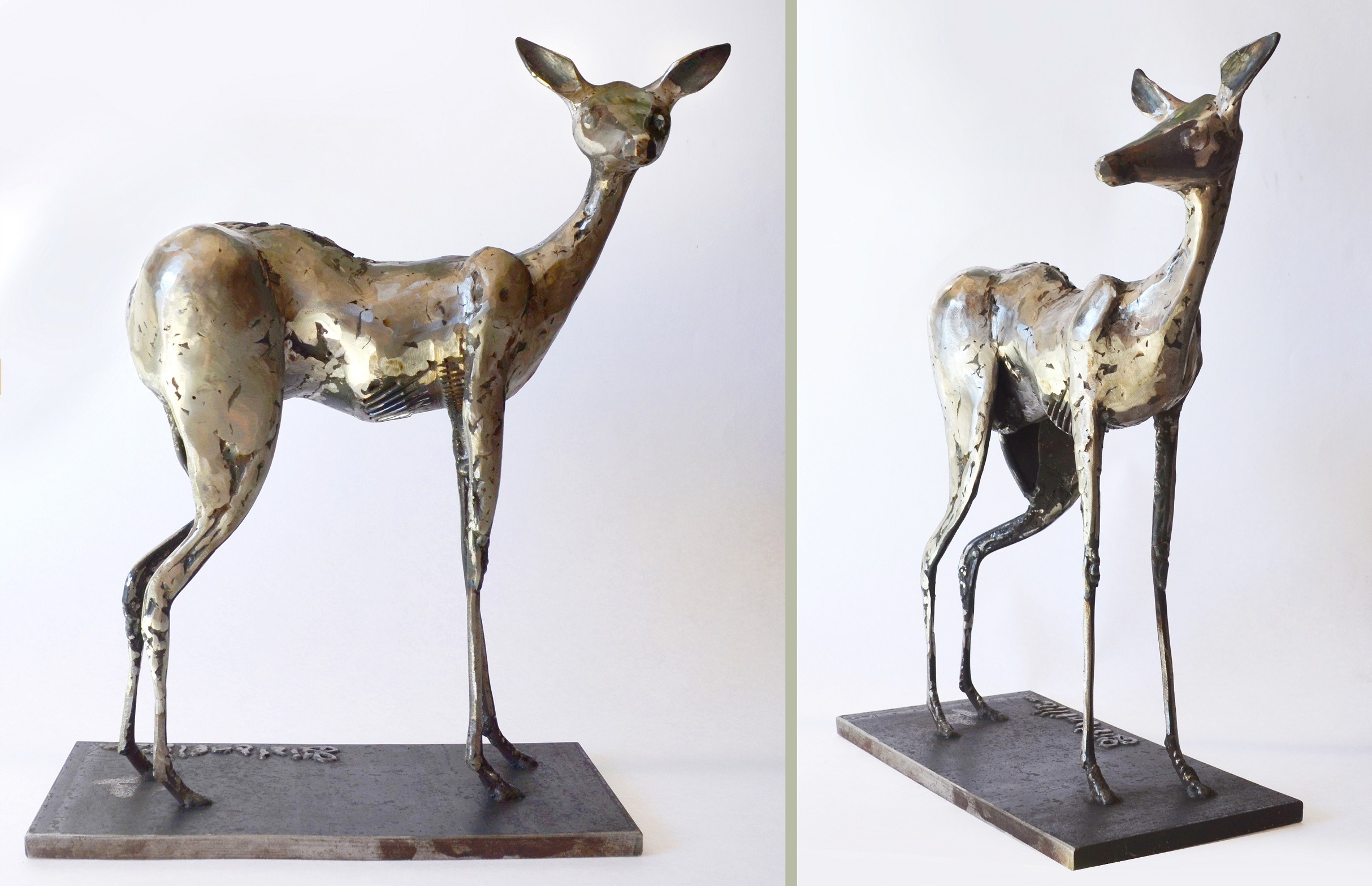
. . .
Jim Gigurtsis
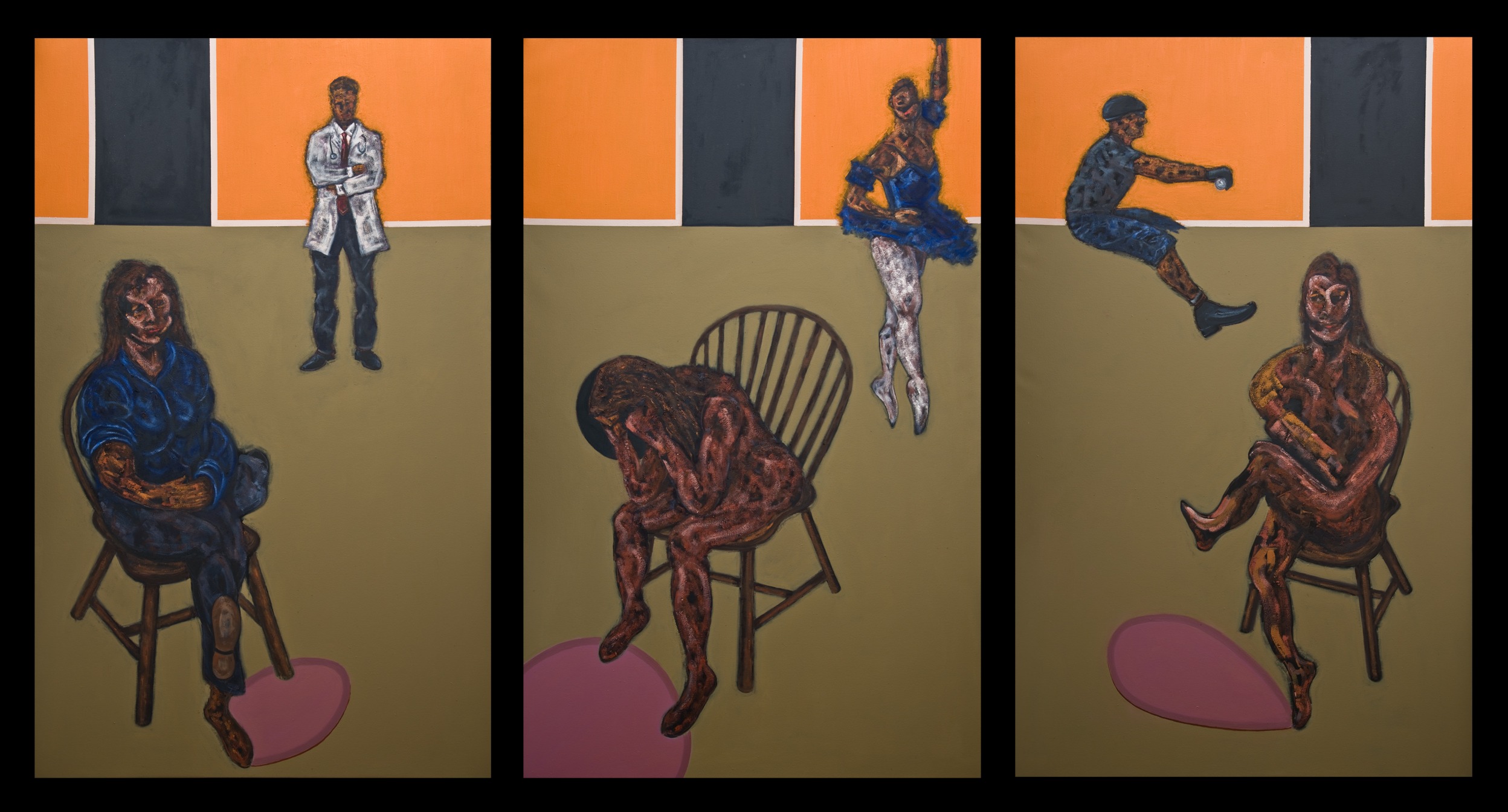
. . .
Inspiration for my art comes from my surroundings, events and news, in addition to my personal experiences and travels.
I create a visual comfort zone for the viewer by using recognizable images, then adding and subtracting lines, shapes and color to stir the viewer’s visual and visceral responses.
My recent work is driven by themes such as “Mortality” or “Decay and Re-generation.” I research my theme’s history and chronology and depict what the theme makes me feel. I depict my subjects from the inside out, giving form to an accumulation of sensations and vulnerabilities.
. . .
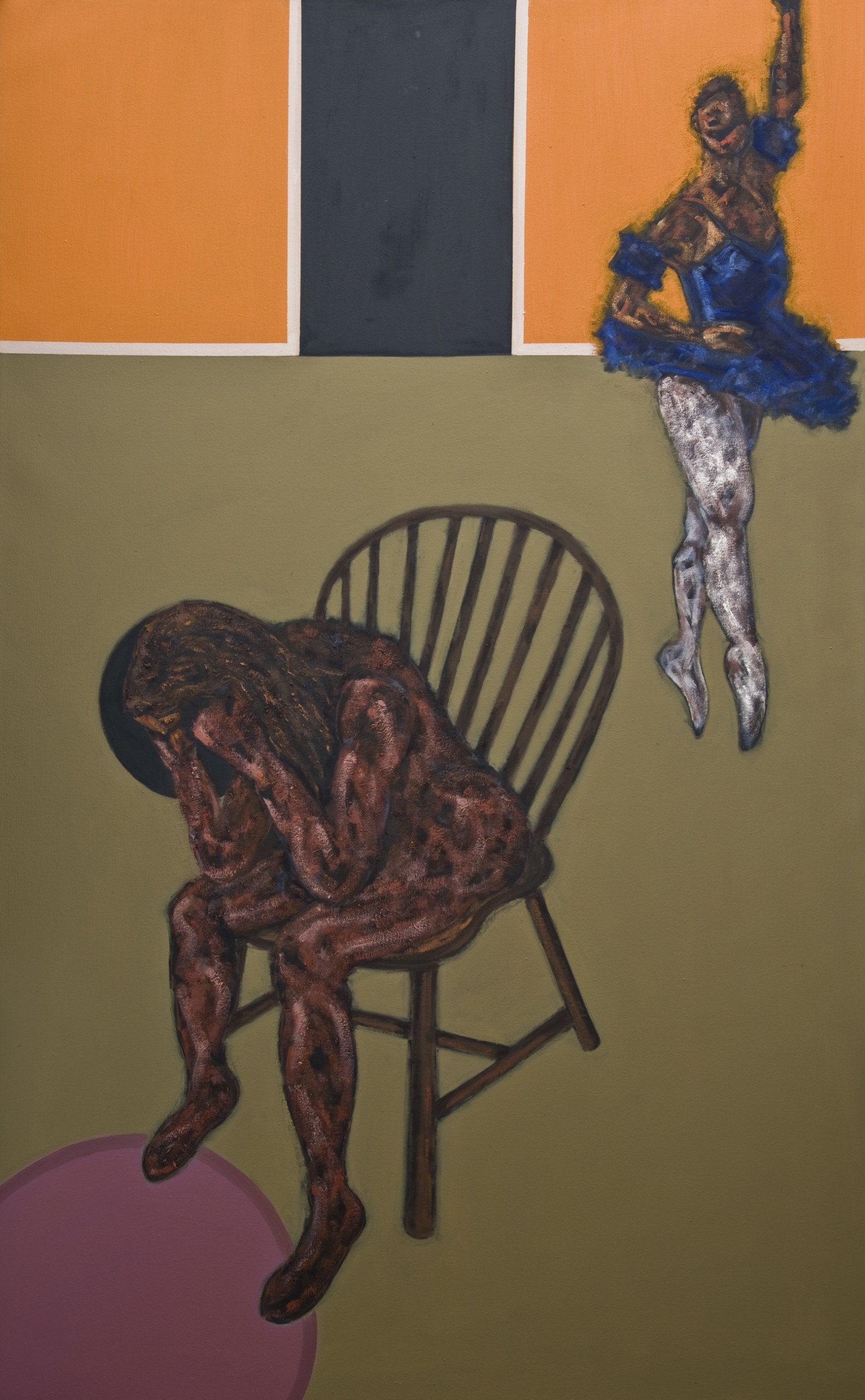
. . .
The triptych 2020 is a very personal piece as it depicts the lament and distress of what the loss of a loved one looks like. The seated person is my partner as she lost not one, but two family members and a very dear friend in the space of just 100 days in 2020.
Decay and Re-generation is a subject that intrigues me as it is a process we all go through on a daily basis. I am depicting human existence at a moment in time where there is contradiction between what is visually expected and my depiction of the essence of the person. For this subject it is all about allowing my emotions and feelings to drive the composition.
. . .
Kevin Grass
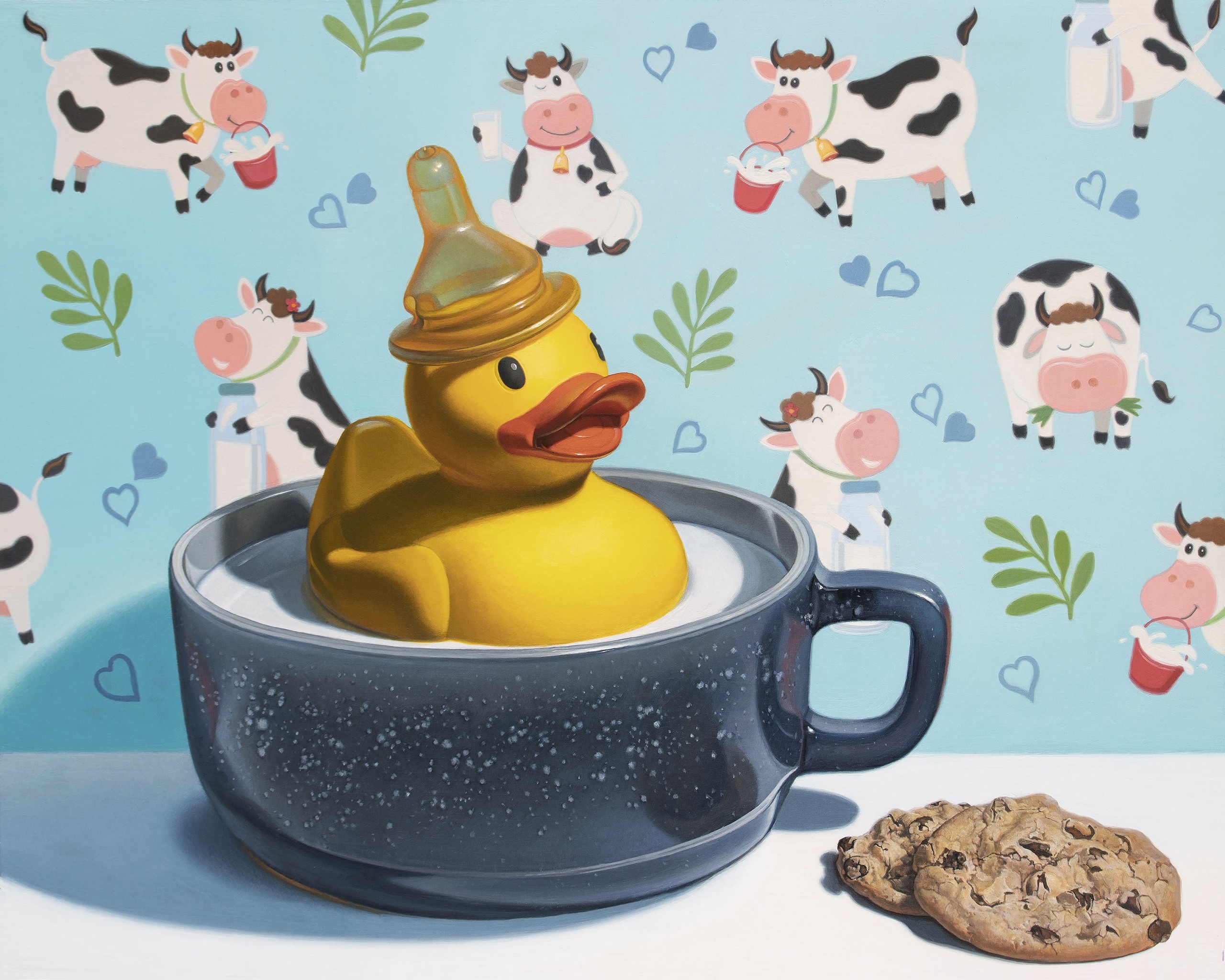
. . .
Definition of Milk Duct – a duct leading from the mammary gland to the tip of a nipple which carries milk to the nipple in breastfeeding women.
By replacing the word “duct” with “duck,” a visual pun is created that is truly lame and worthy of a groan. But it is also definitely fun and cute.
A yellow rubber duck wearing a baby bottle nipple as a cap floats in a large cup of milk. Wallpaper with cows carrying containers of milk serves as a backdrop for the image. Chocolate chip cookies are included in the design because you simply cannot have milk without cookies.
. . .

. . .
Definition – a device used by hunters for imitating the calls of ducks.
This image interprets “duck call” to mean a telephone call made by ducks. The small rubber ducks tweet into the receiver and the large rubber duck listens at the earpiece. The abstract leafy pattern suggests nature, or camouflage, which implies the original meaning of the term.
. . .
Steph Hargrove
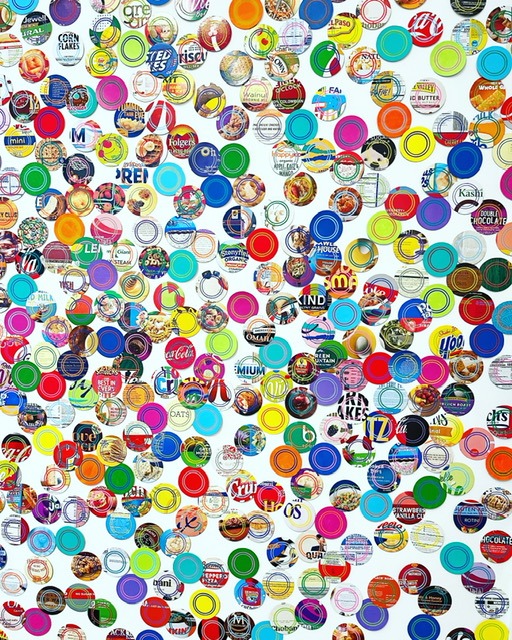
. . .
Artist Steph Hargrove presents Feedback – an art installation featuring 3,404 “plates” made from food packaging, with each plate representing 10 food insecure children in Pinellas County.
A second statistic is worked in with solid color plates representing the children who are newly food insecure due to the COVID-19 pandemic.
. . .
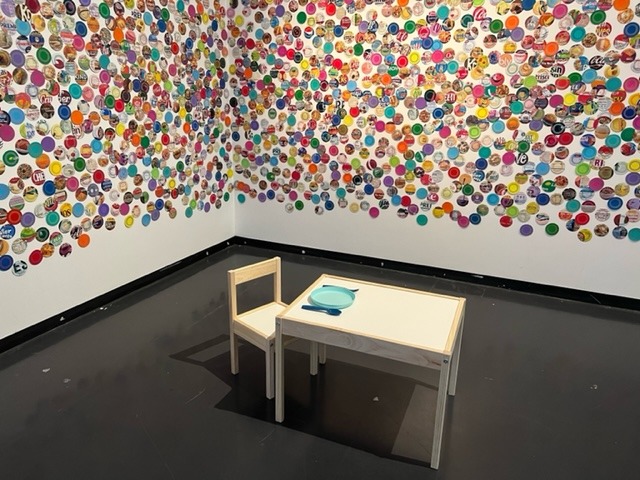
. . .
A wood tabletop mounted to the gallery wall allows viewers to “put food on the table.” A $10 donation allows visitors to add a food sticker to the tabletop and provides 50 meals to hungry families through Feeding Tampa Bay.
Feedback has generated over 3700 meal donations so far!
. . .
Kenny Jensen


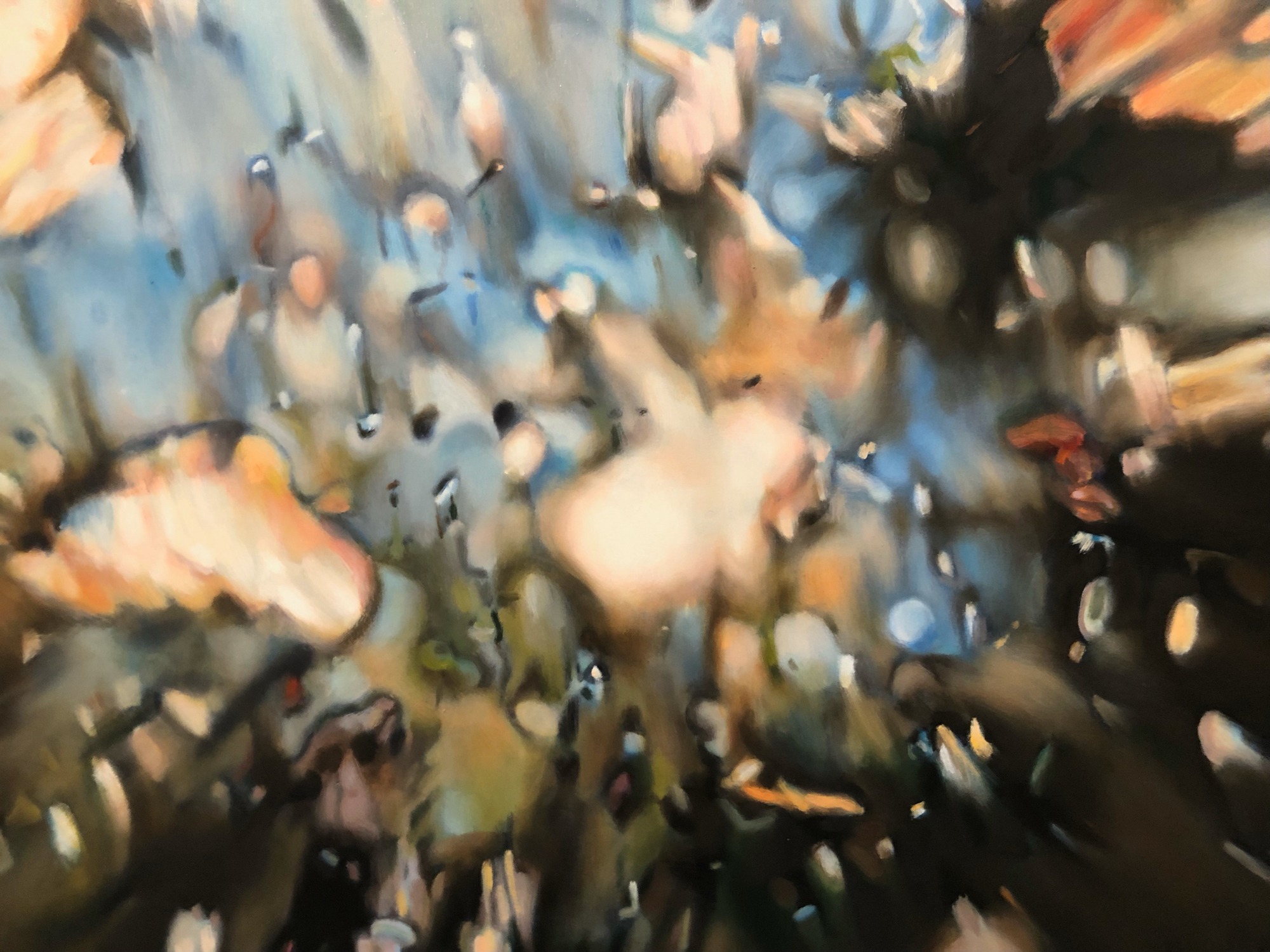
. . .
D YaeL Kelley
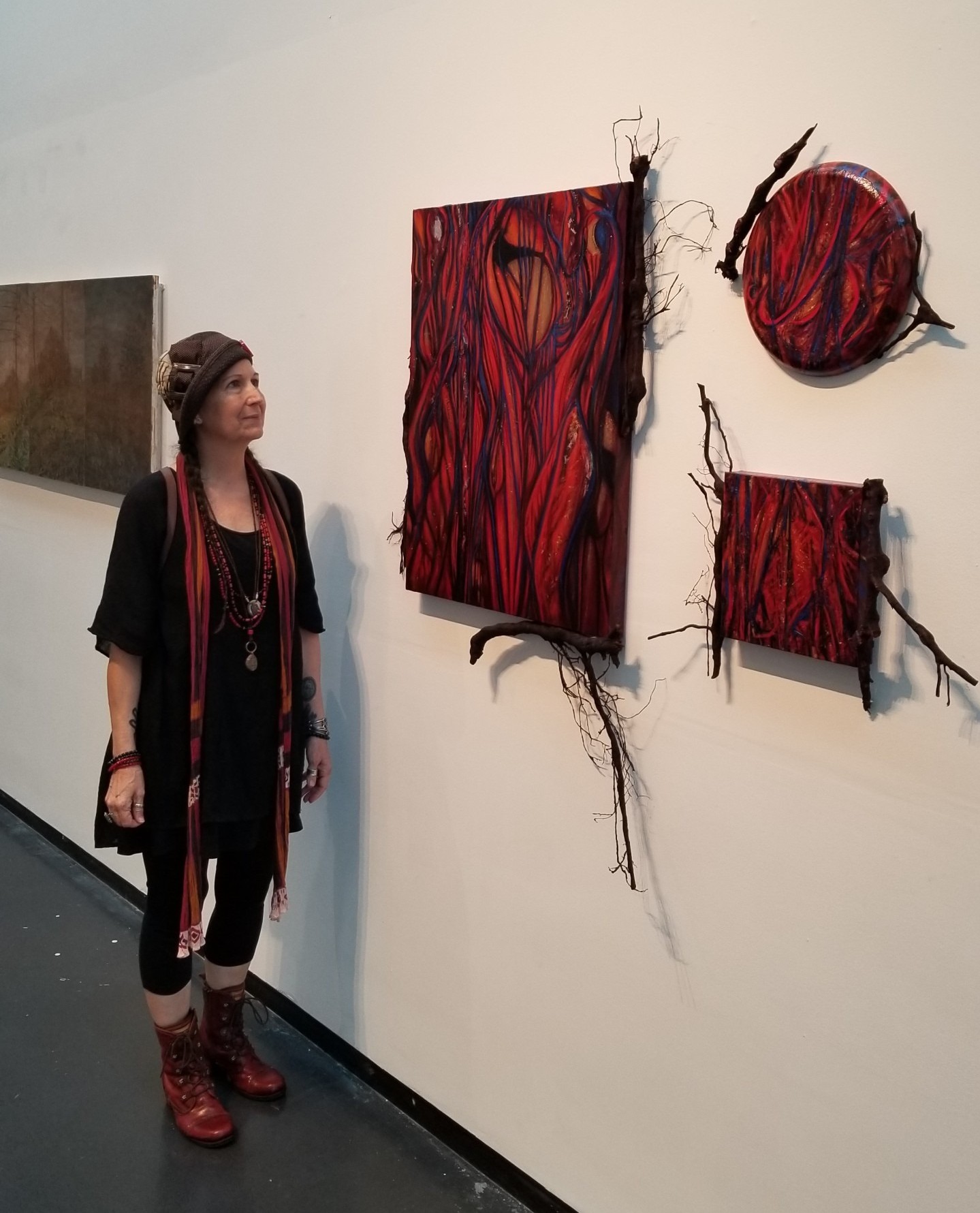
. . .
These paintings are part of a series titled Rootwork: Ecstatic Dances.
The concept of this series is inspired by my studies of Kabbalah and Sefer Yetzirah over the last 40 years. Expressions of Ein Sof and of the divine feminine through the Kabbalistic tree of life. Exploring the sephorot of Binah, Hokmah and Shekinah (the three mothers). Understanding Transcendence through working with Immanence.
It is a deep dive into the earth and our own bodies as reflections of empowerment and divinity.
. . .
. . .
Akiko Kotani

Date: 2002-2004
Medium: Silk drawing stitched on 3 layers of silk organza
Size: 45h x 181w x 2d inches (4 panels)
. . .
These silk layered works started after trying mightily to hold onto a dream I had as I awoke.
You know how this is. . . as you try to hold on to the dream it gently moves away from you.
Then you see the light of day and it dissipates into thin air.
At that moment, I wondered how I could depict an image reseeding from oneself, the movement of that image.
It also had to be gentle like a dream just disappearing as one tries mightily to hold on to it but it involuntarily moves away and dissolves.
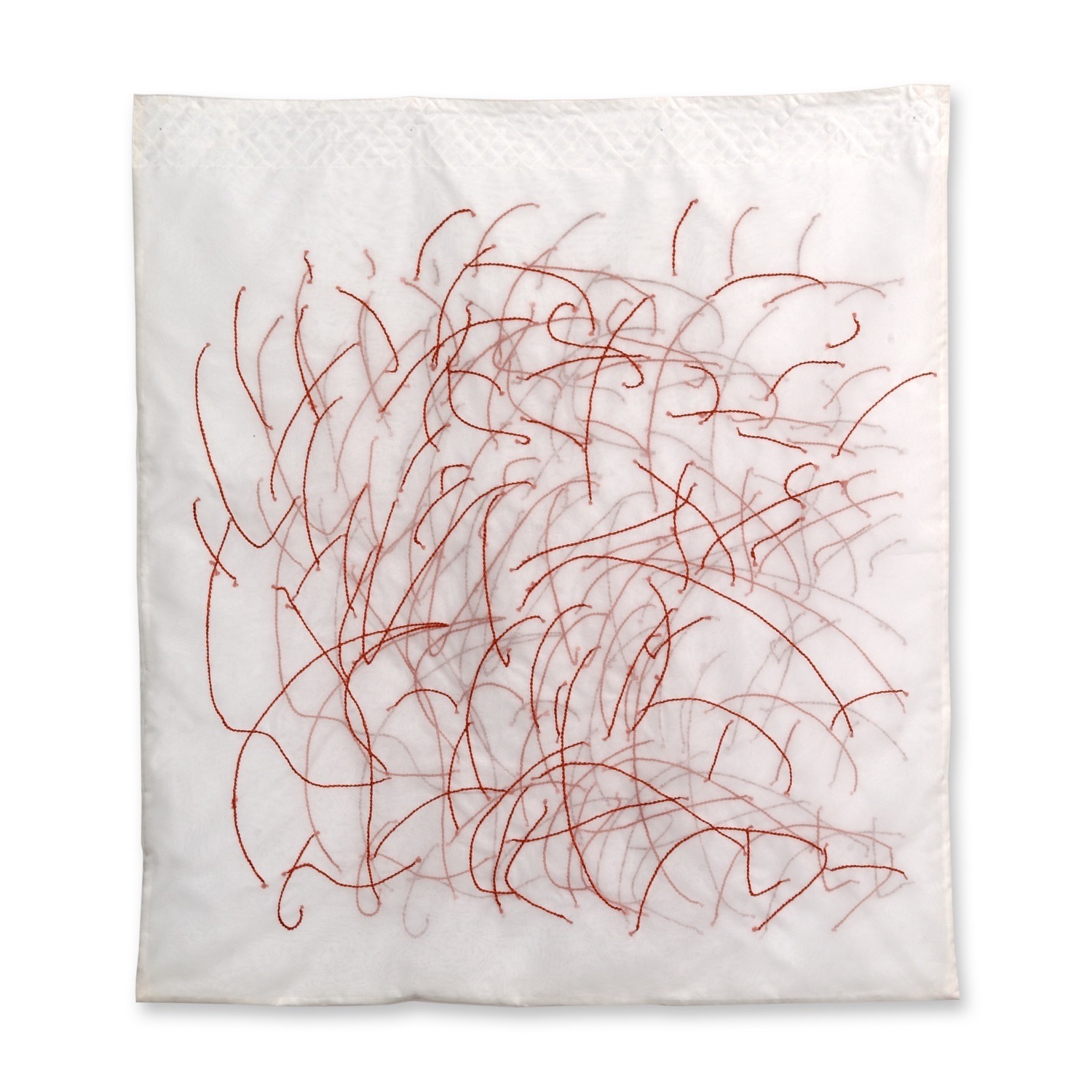
Date: 2002-2004
Medium: Silk drawing stitched on 3 layers of silk organza
size: 45h x 43w x 2d inches (each panel)
. . .
This series consists of 12 panels called The Grass Series.
4 panels called Tender Grass, (now in a collection in the south of France)
4 panels called Golden Grass, now on display at the Artist-Naples, Baker Museum Exhibition.
4 panels called Burnt Grass that is shown here.
This series is about one’s stages in life.
Tender Grass depicts youth, vulnerable and innocent.
Golden Grass is the stage I am currently in, older with hard-earned wisdom.
Burnt Grass is in the Buddhist tradition of cremation, depicting my dancing bones within the fire (again suggesting movement).
. . .
Cora Marshall
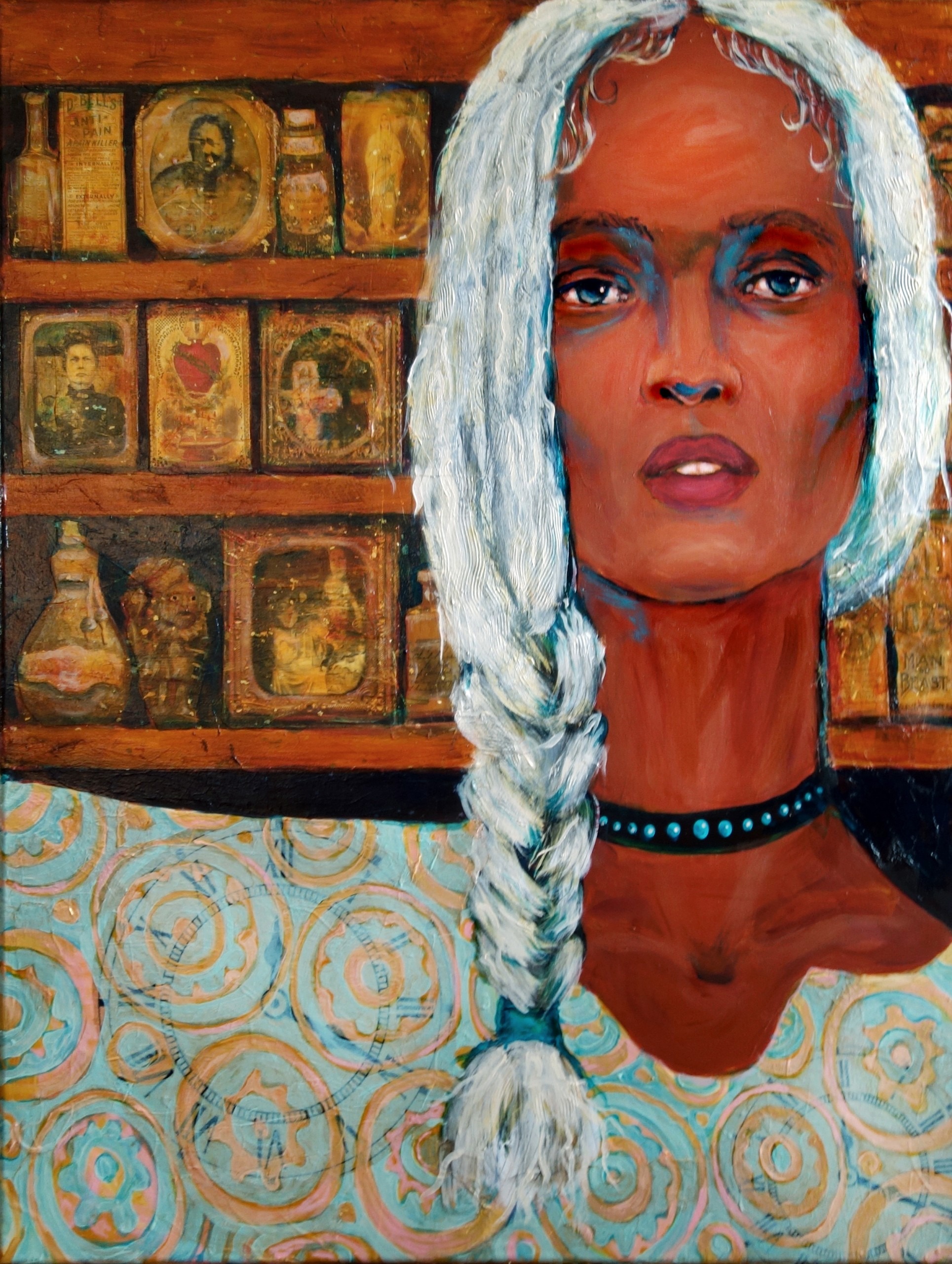
The series. . .
Lately, I’ve been thinking about the mystique of time.
For example, I think most folks, no matter how old, in their mind’s eye, see themselves at a younger age. (Maybe that’s why so many of us use filters to smooth, correct, erase characteristics that make us look older). For me, in my mind’s eye, I’m looking 45ish. (Ah, the mystique of time.)
. . .
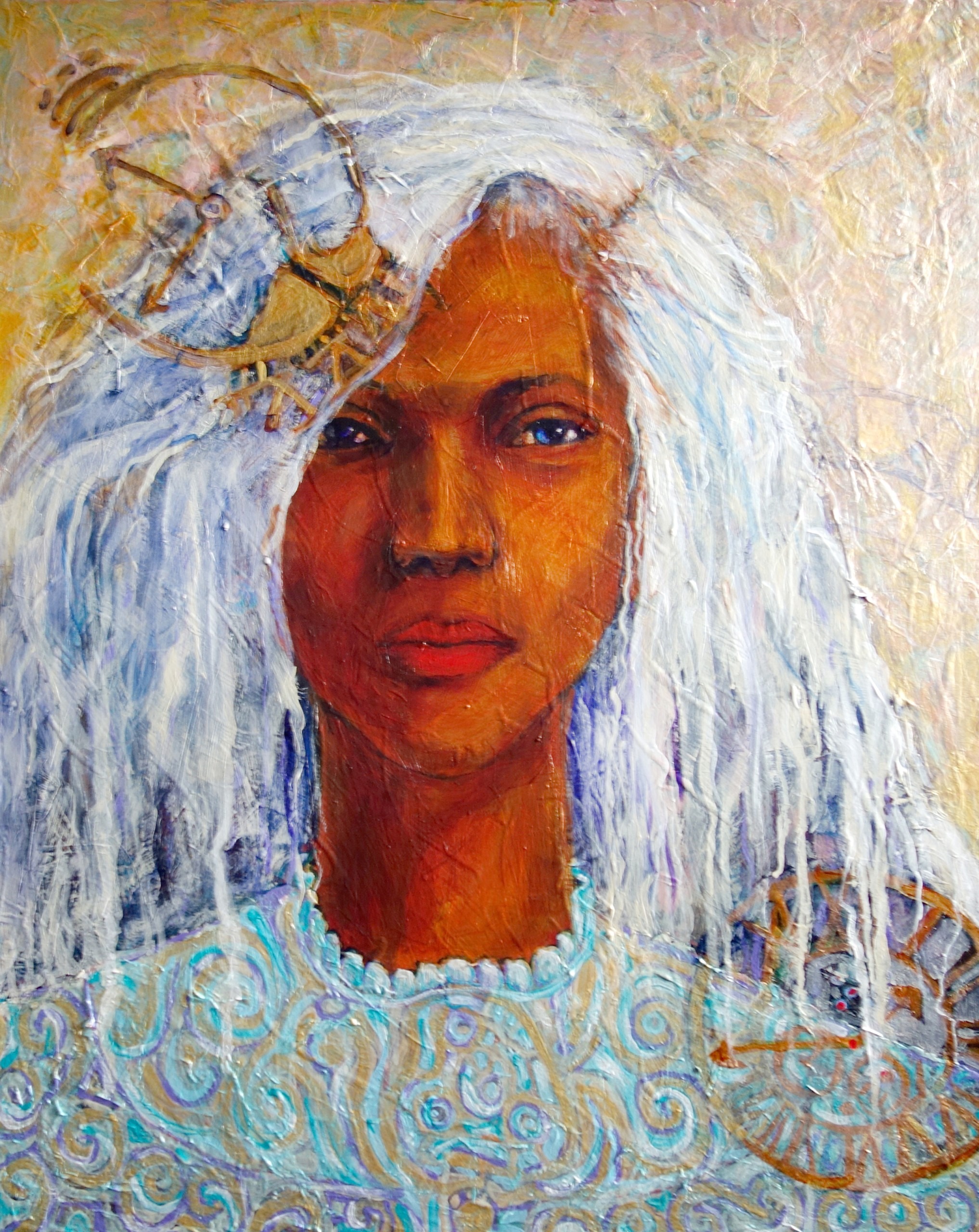
In these paintings, young faces with grey hair represent that dichotomy. With these paintings, I am exploring ideas of time and texture.
. . .
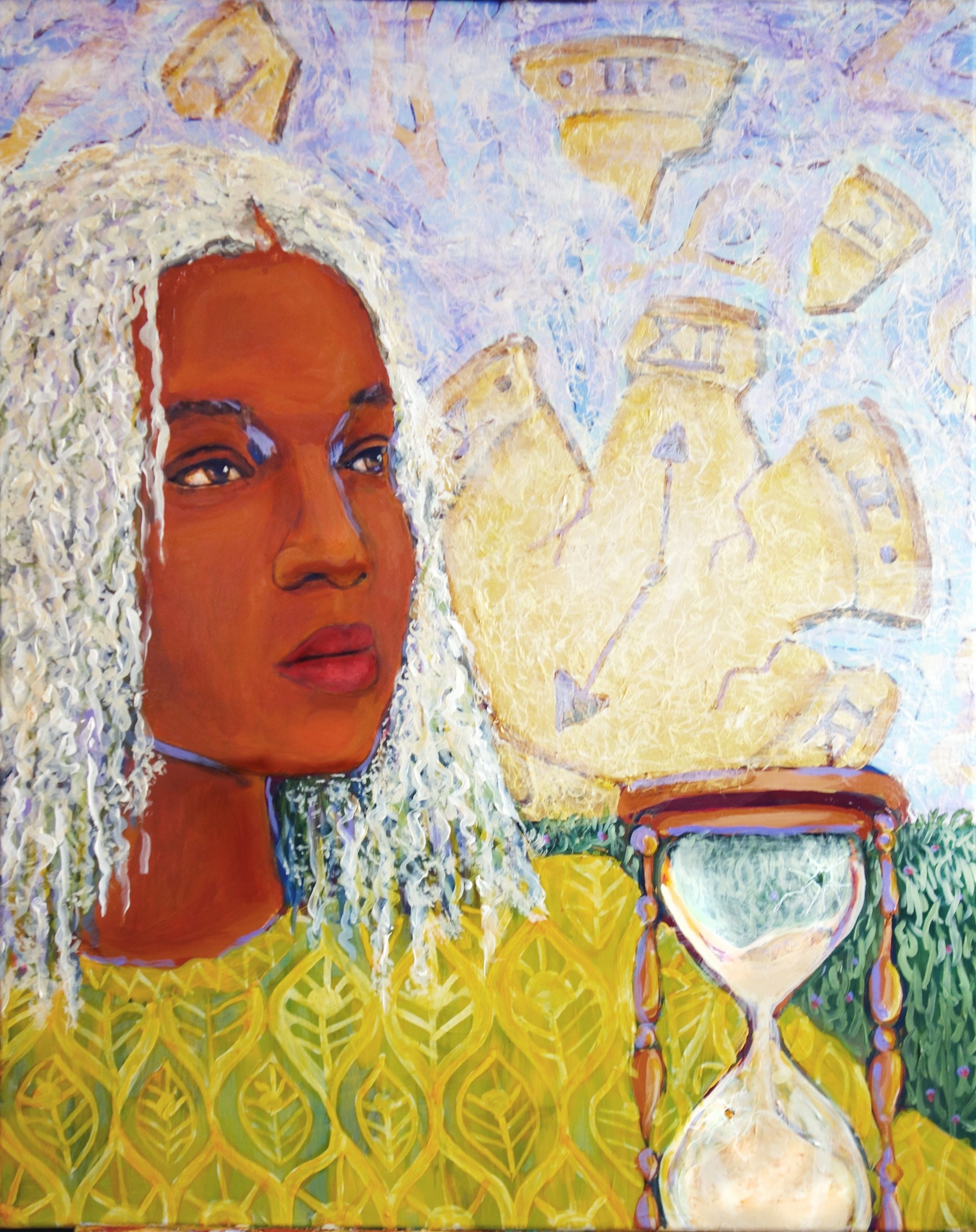
Time lost is never found. Thinking about the time we all have lost during this time of pandemic that we’ll never get back again.
. . .
Cynthia Mason
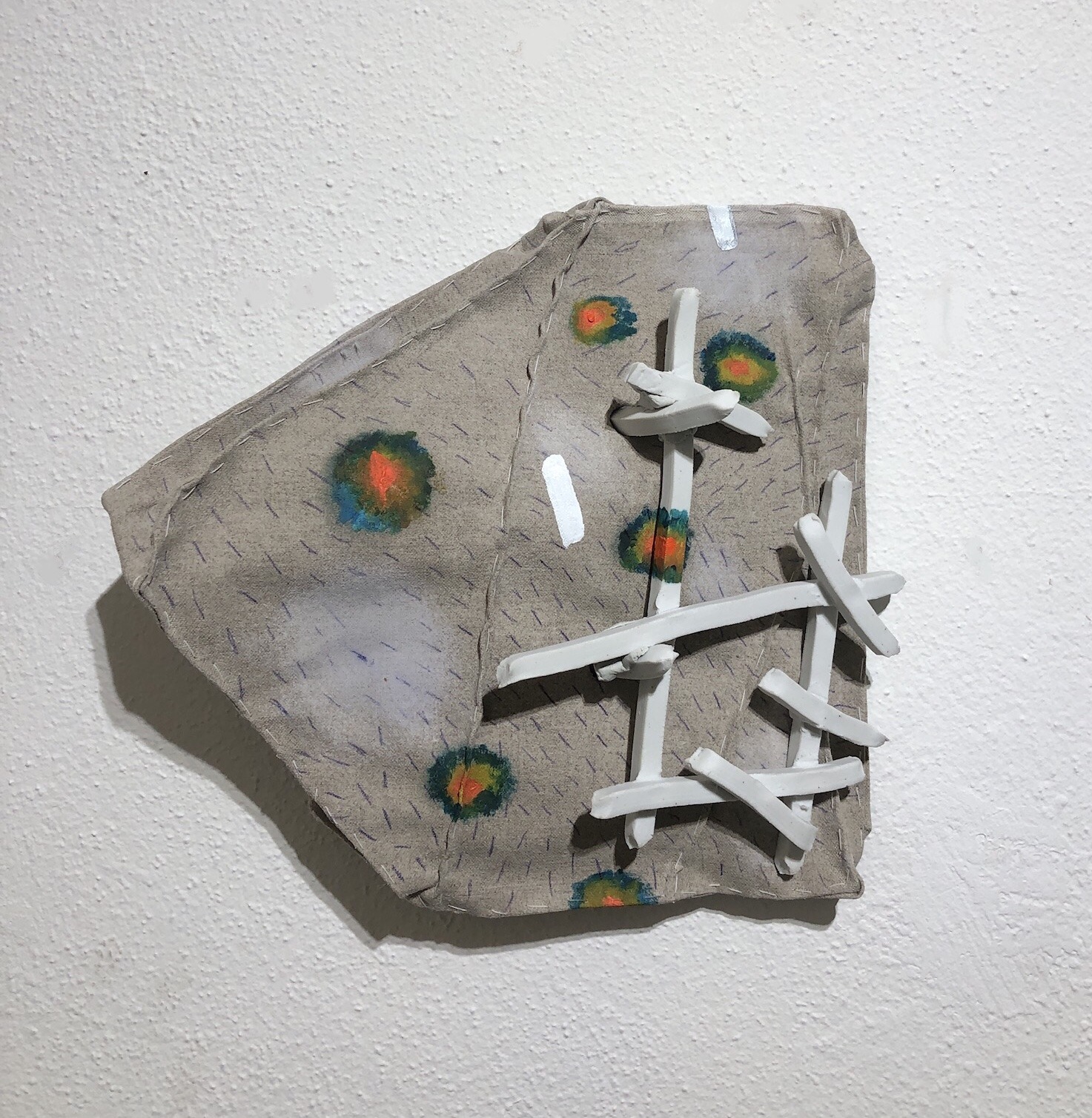
. . .
In this work, structure becomes the subject. The materials — linen, porcelain, shredded documents — which belong to our domestic and work lives, are layered and compacted.
. . .

. . .
On their surfaces, color tracks time and motion. Internally, shredded documents act as filler for the events being rendered.

. . .
The fragile porcelain grids rely on the soft painted linen forms for support. I am interested in turning the forms inside out, a makeshift solution using everyday materials.
. . .
Mickett-Stackhouse Studios
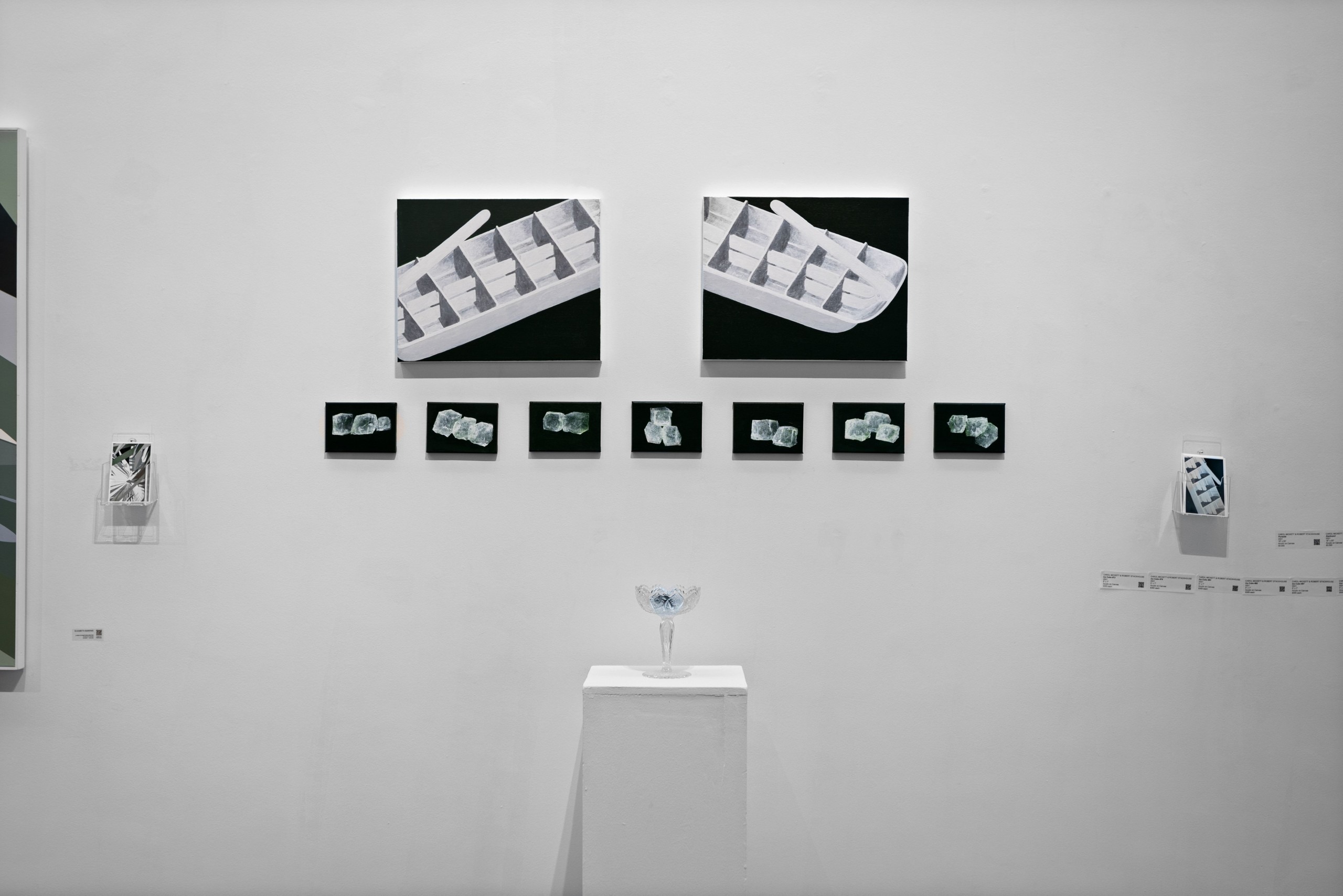
. . .
Our installation at Creative Pinellas is a continuation of our Ice Cube Tray series. Our ice cube tray is a symbol for taking action to cool our waters. After all, if you want to cool water – add ice.
The ice cube tray can also be seen as a lifeboat. The installation also includes ice cube paintings. These, of course, would be ice cubes that had been in the ice cube tray.
There are some people who see the ice cube tray – since it is empty – as an indication that our global ice is melting. All to show that addressing climate change, our rising waters and their warming is necessary.
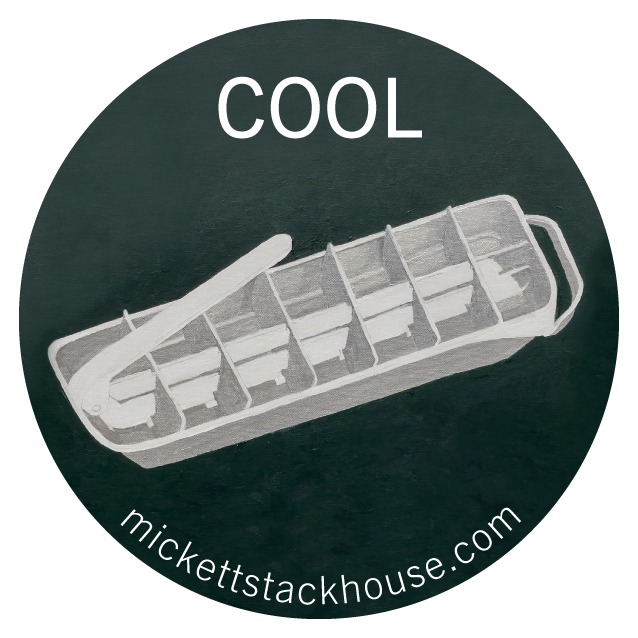
. . .
We are currently on board the Schmidt Ocean Institute’s ocean research vessel the Falkor. We are close to our final destination – Vigo, Spain. On the Falkor, every day at 2 pm ship time, an ice cube gets thrown in the ocean (Pacific, Caribbean, Atlantic).
The 25th ice cube was thrown in today by Allan Doyle of Scotland who is the Chief Officer. Everyone in the crew has, as of today, thrown an ice cube in the ocean.
We post a video of this event on Instagram and Facebook. We also make an ice cube painting each day with the latitude, longitude and water temperature at the time the ice cube was thrown in.
. . .
Mark Mitchell
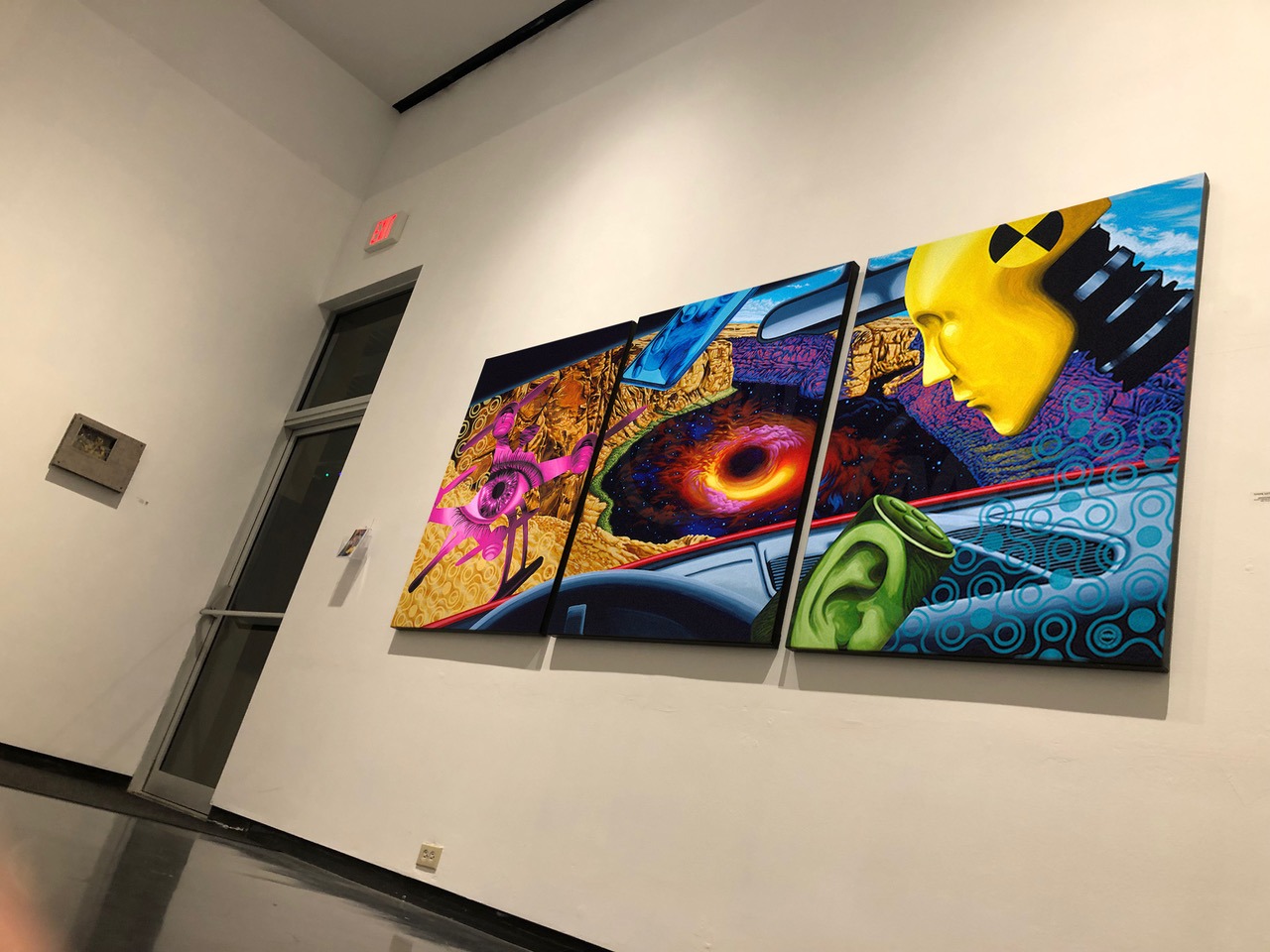
. . .
What began as a reaction to the advent of self-driving vehicles evolved into a broader statement for me.
It struck me as surreal and somewhat horrifying that we may soon be sharing our highways with robotic cars and trucks with no one behind the wheel. And also that, over time, the population would eventually resign all of their driving responsibilities to computers and lose their personal driving skills altogether.
I find this kind of creeping societal surrender to technology unnerving. And so, this large-scale triptych is the centerpiece of my Distractions series — an exploration of misplaced priorities in society.
As humans living in a complex world of perpetually-evolving technology and leisure activities, we can easily lose our awareness of the big picture. Shiny objects, new toys and our desire for pleasure demand our attention — oftentimes taking our focus away from urgent social and environmental crises, as we unwittingly sacrifice essentials like privacy, safety, health and empathy.
The spinner-toy pattern appearing throughout the series is a nod to the transient and vacuous nature of these distractions. The viewpoint through the windshield reveals a tech-obsessed society relinquishing control as we collectively hurtle over-the-cliff toward a dubious future, metaphorically represented here by a black hole in space.
. . .
Zoe Papas

. . .
At the Arts Annual Exhibition, you can see three of my double-layered drawings. The cutouts of these drawings allow me to create meaning beneath the surface.
The most recent of these is titled The Sower, which shows potential for growth. In the foreground, the figure is holding a seed, and in the background, the seed’s potential is revealed in a field of flowers.
Another recent drawing titled From the Ashes is also on display. It is based on the idea of overcoming suffering, represented by the ashes. The light is the person’s faith and inner strength that is allowing him to pull himself out of a negative situation. The person emerging from the ashes evokes the same resurrection imagery as the phoenix’s rebirth or the biblical story of the fiery furnace.
Gianna Pergamo

. . .
Gianna’s work centers around her love for animals. Whether outfitted in vintage clothing or transformed into a hybrid mermaid creature, her loveable cast of deer, pigs, raccoons, otters, cats and more all have their own special stories to tell.
Her interest in all types of animals is ever expanding as she finds inspiration in wildlife and the local nature parks surrounding her, as well as ecological research. Gianna’s favorites are the alligators, as she transforms foreboding and aggressive creatures into charming beings.
. . .
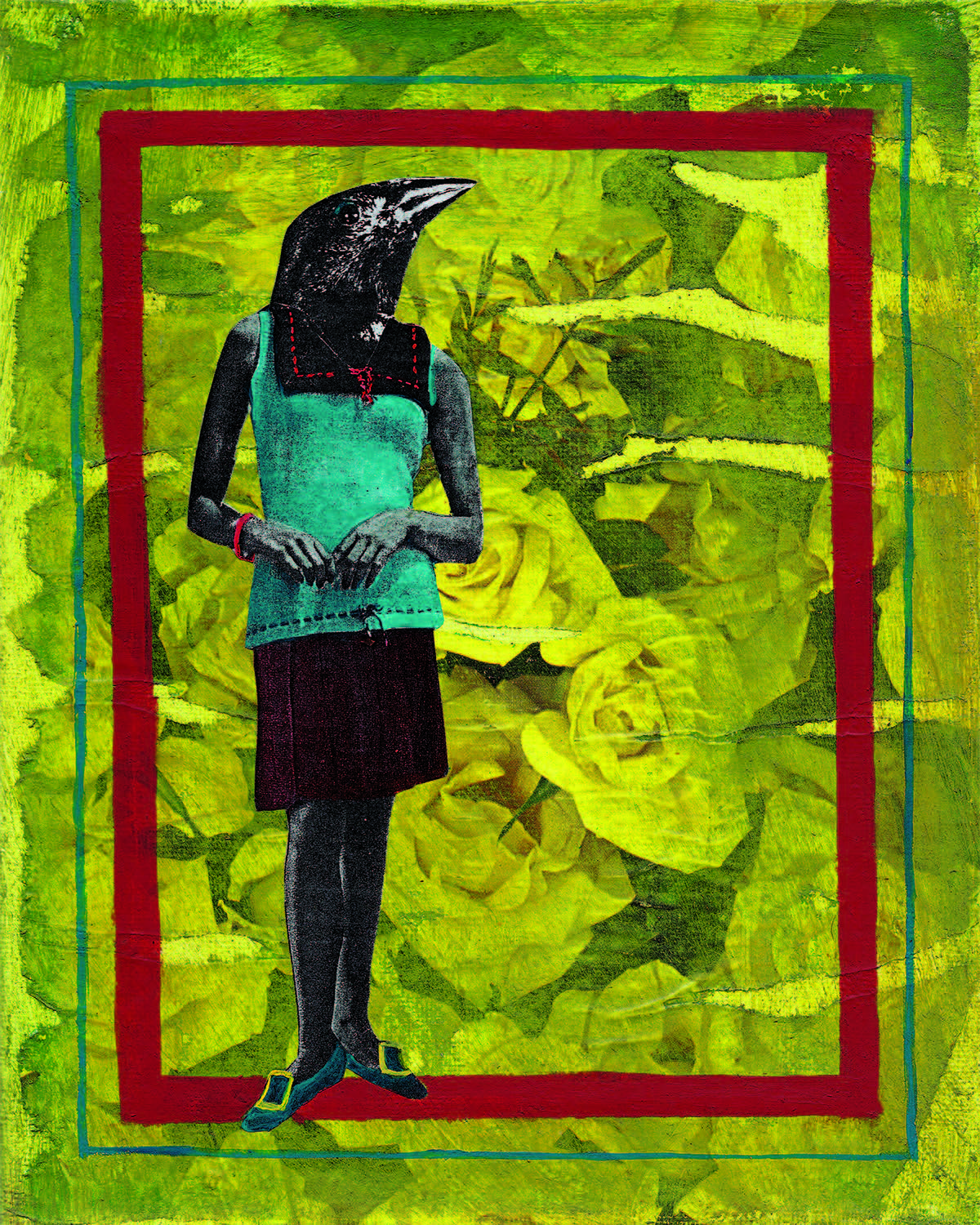
. . .
Gianna usually works on several pieces at once so she is able to mix and match collaged pieces with painted ones. In this way a painting rarely follows a linear progression to its completion – starting with the intent of the pieces rather than a detailed plan. This allows her to have a more fluid and fun relationship with her characters as she responds to their individual dispositions and creates thoughtful worlds to suit each new animal friend.
She begins her process by loosely sketching various scenes, interactions and compositions. She then compiles imagery creating characters and scenarios that fit. Sometimes several paintings will be integrated into one, or one painting will be deconstructed into two or more. In this way, Gianna approaches her work as more an act of discovery than a task to be completed.
. . .
Rose Marie Prins
From time to time throughout my career I have explored sculpture. However, these sculptures represent a new beginning.
. . .
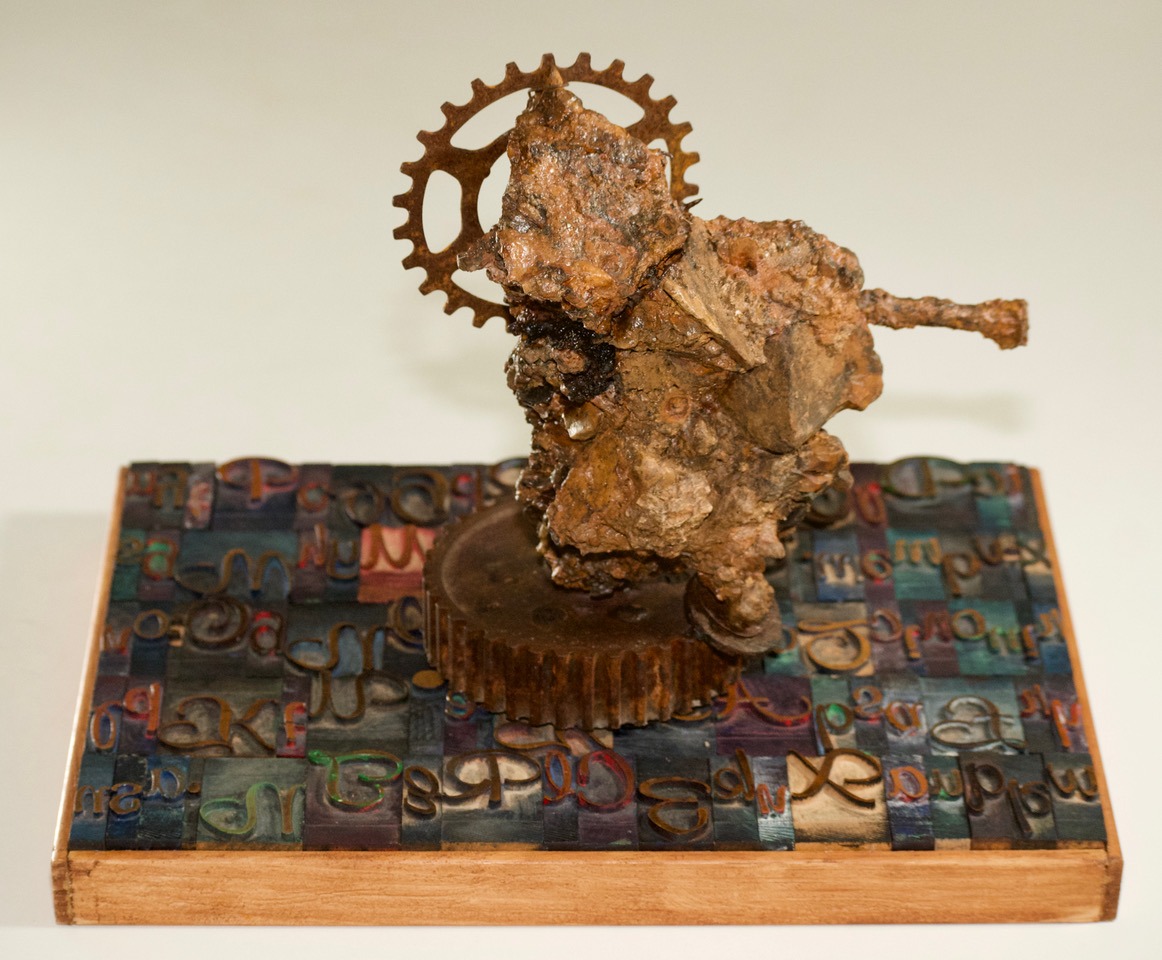
For a long time after the sudden death of my son I was unable to make art. Inspiration left me. During that time I published a book, A Leaf in the Wind: Poems by Jaro Majer, Artwork by Rose Marie Prins, with my son’s poems and my watercolor and Sumi ink images. The book was part of my grief therapy.
. . .

Then, early in 2021 I started playing (yes, playing is the right word) with found objects in my studio. First I created “Untitled (Yearning…).” This was followed by “In the Beginning…” and “Filipino Rain Dancer.”
. . .

More pieces from this series are evolving in my studio. I can only describe the process as freeing—I am being freed from the constraints of inconsolable grief.I know that a part of me will always grieve for my son, but gradually I have come to accept my loss.
. . .
Babs Reingold
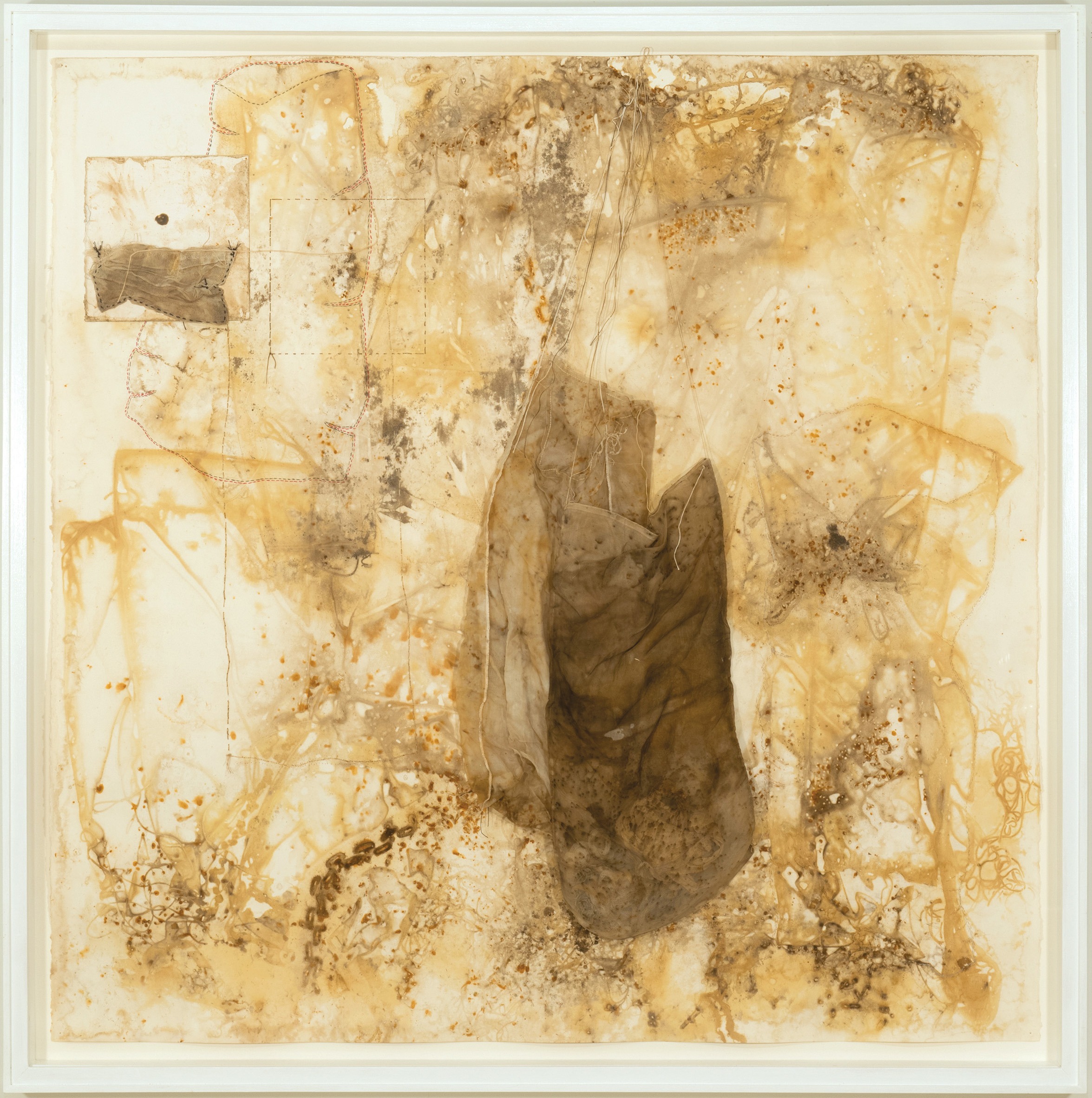
. . .
The Chinese Wu Xing system lists wood, fire, earth, metal and water as the five elements. This explains the nature and complexity of all matter in terms of simpler substances.
My work touches on all the elements as I seek to translate, disclose and disseminate our emotional realities. Time. . . and accumulating objects over time are manipulated, exposing the seen and not seen.
Layers, and the illusion of layers, are integral to surface just as illusion is always beneath the surface. Skin and Vessels explores this premise, the hidden physical, emotional and spiritual layers and the chimera integral in all layers – ours, a structure, whatever. It is an underworld depicted in marred and pocked marks and punctured here and there with thread and stitching. It continues a theme I have been exploring for the past two decades or so, that of surface and a biography beneath the surface. I reference not only humanity but the topographical life and layers of all objects.
. . .
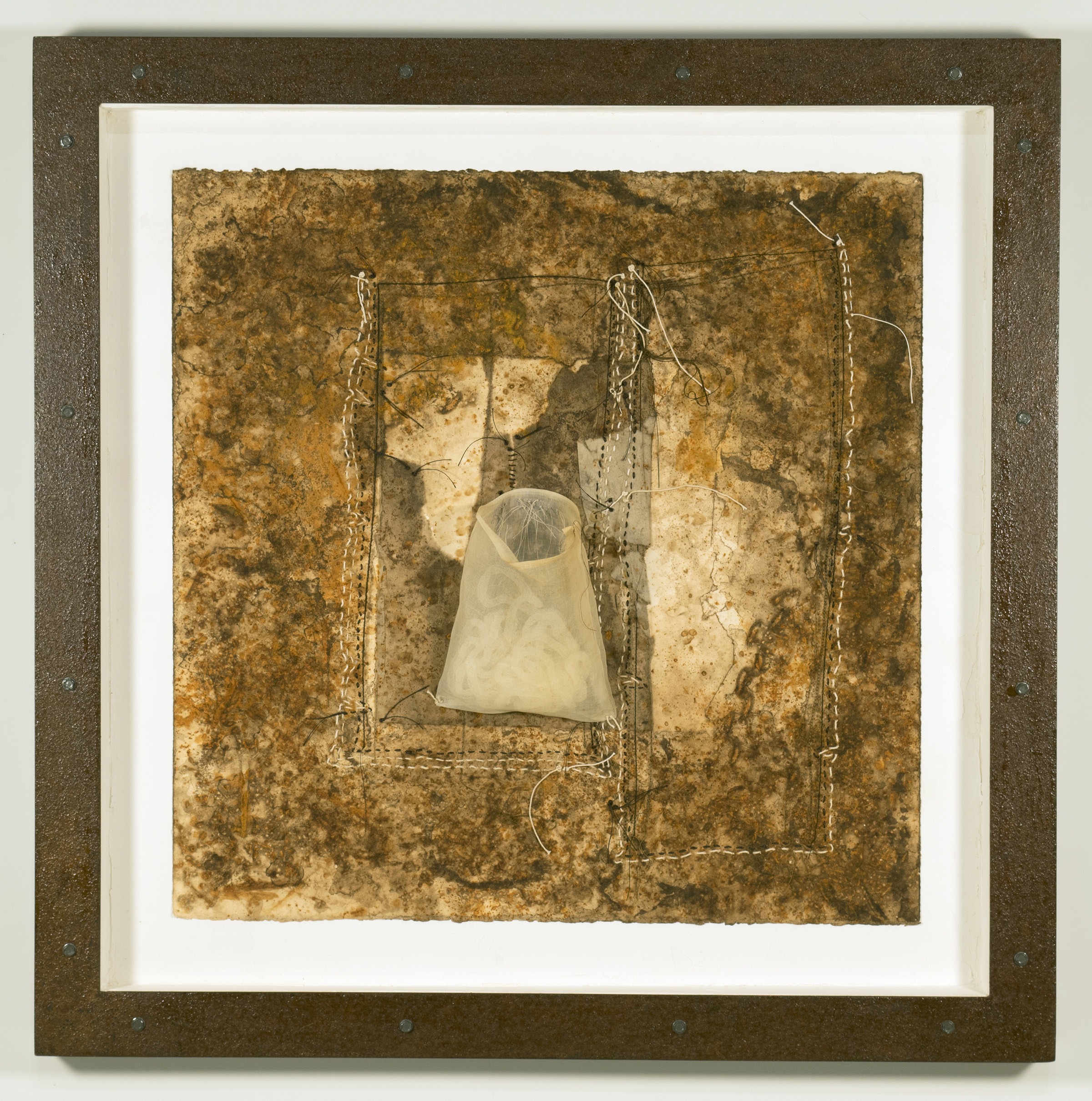
. . .
The pieces are created with scratches and punctures that sully the surface along with a staining process developed over many years. These baths, which contain different elements and intensity, combine rust from found objects along with pellets, nails, steel wool, chain, string and tea. The objects leave their decomposing marks on the skin of the paper or treated surface, penetrating to varieties of depths. Other materials are added, such as silk, thread, yarn, modeling paste, matte medium, human hair and encaustic.
. . .
Gabriel Ramos

. . .
Through the process of drawing, I create compositions that challenge the viewer to look closer and investigate the imagery presented to them. At many times through this intuitive process, the evidence of the hand becomes apparent.
In addition, an index of time spent is quite evident in many of my pieces. A lot of my inspiration comes from my childhood memories of my home in Puerto Rico and my personal experiences as a Latino living in the United States.
I also pull inspiration from themes such as cultural amnesia, identity, displacement. The overlapping layers, lines and imagery in my works create a constantly changing experience of the fragmented landscape that depicts my struggles and resolutions of my identity.
. . .
Ari Robinson
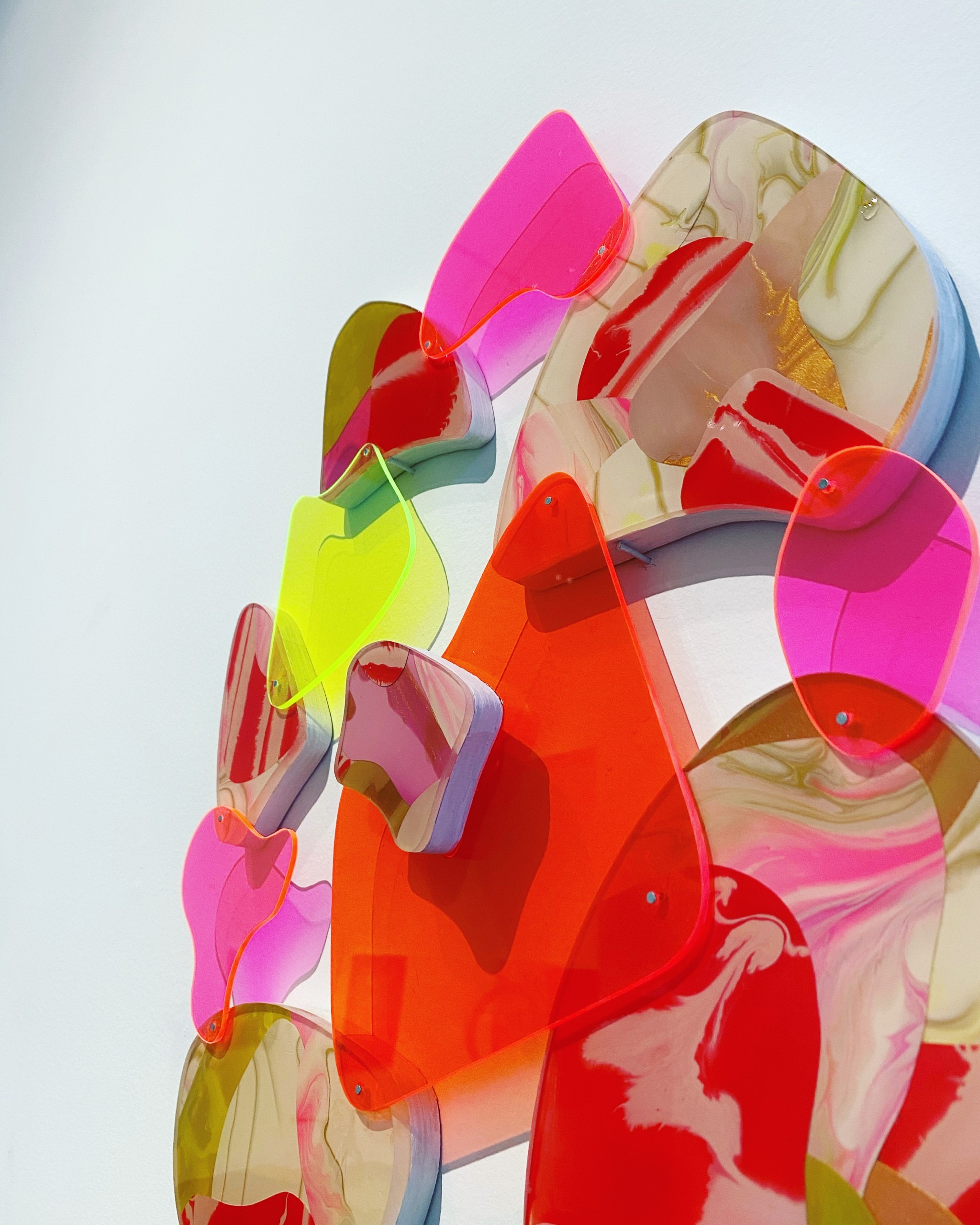
. . .
Bringing memories and reminiscent feelings of natural forms, fascination with the sea, landscapes and vibrant color, my work can be seen as both irregular and ordered, with a sense of pattern and chaos that exist together.
This piece is the first in a new body of work I am starting that involves combining different materials and shapes and playing with color and light.
. . .
Xina Scuderi
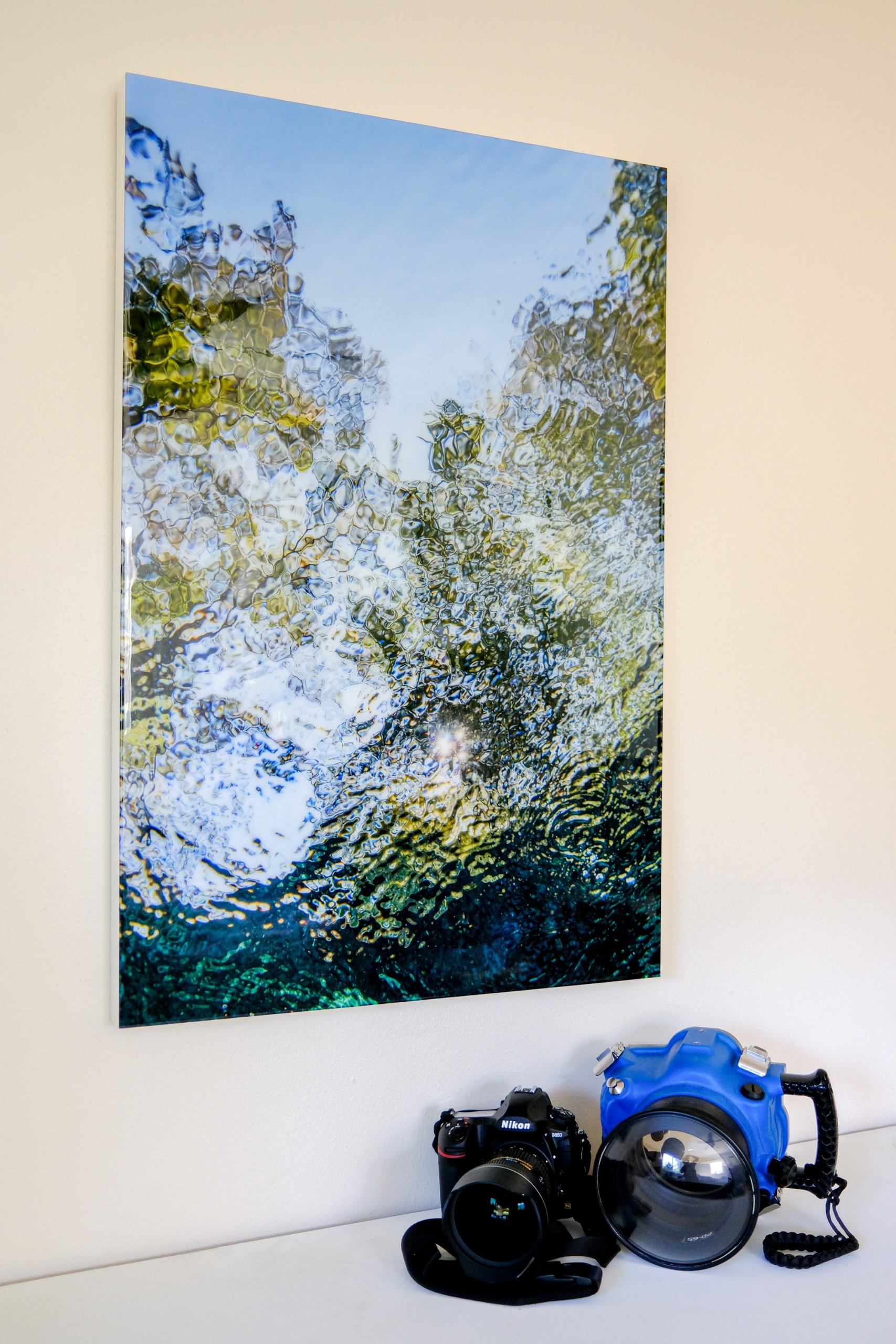
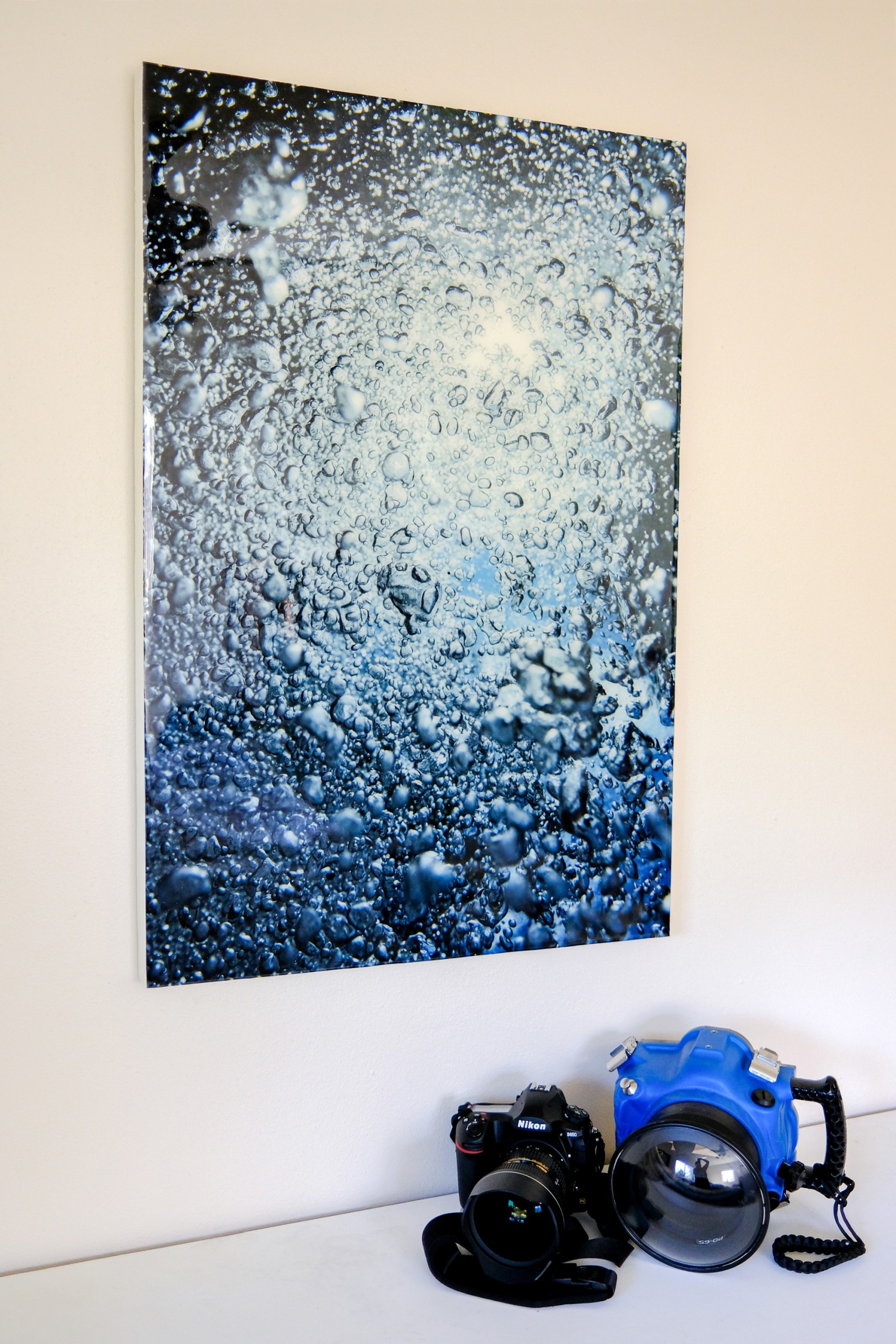
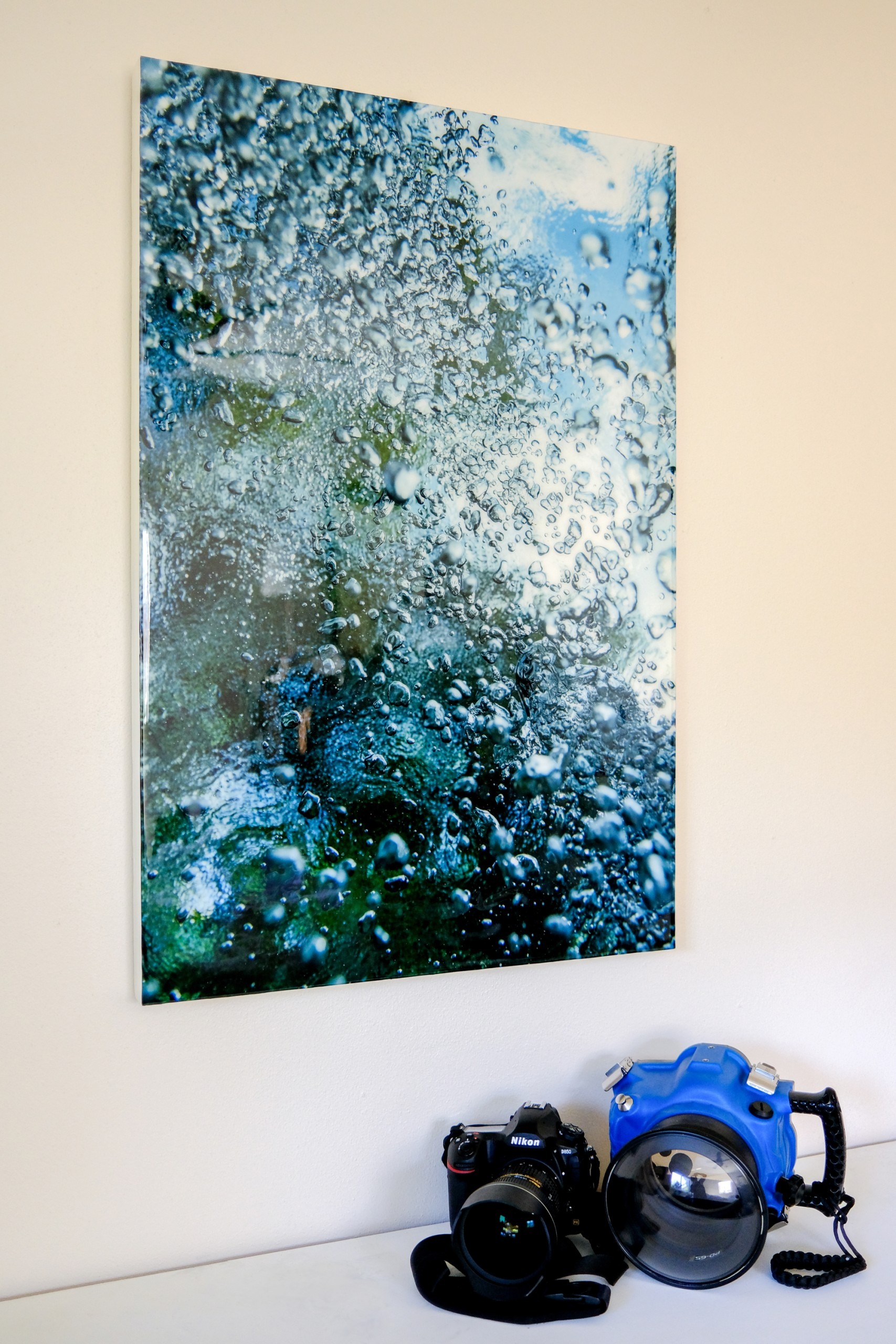
. . .
Angela Warren
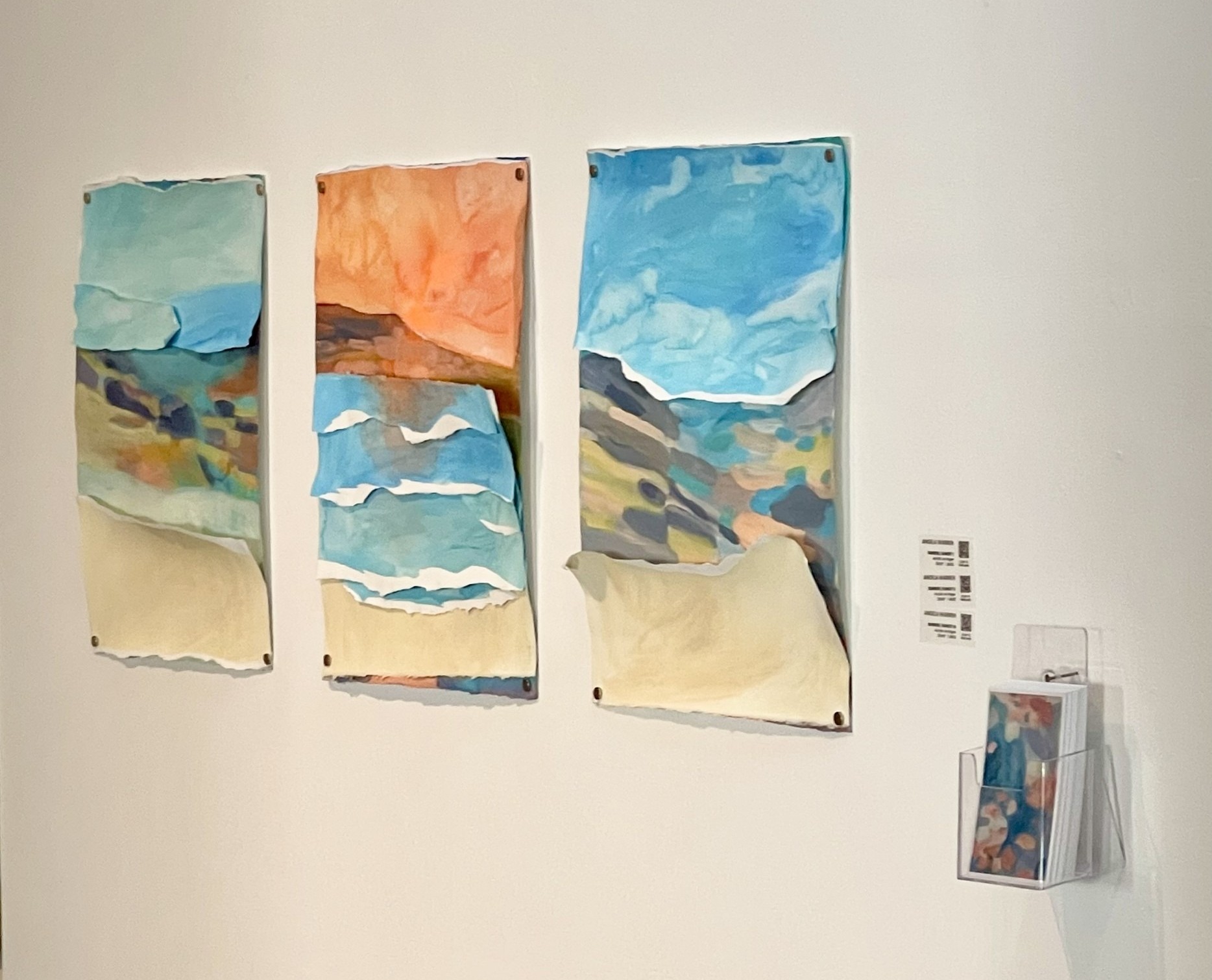
. . .
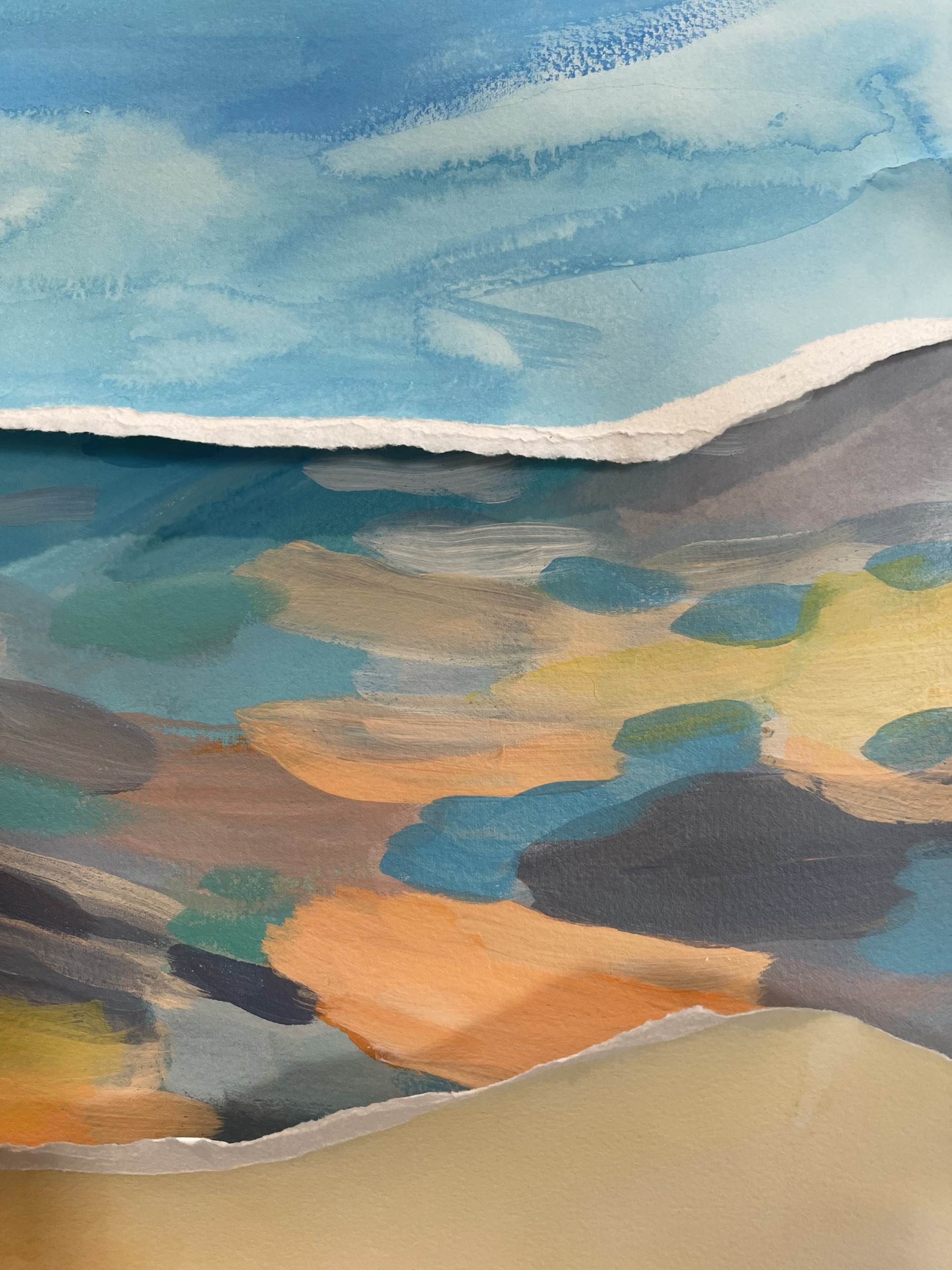
. . .
Joseph Weinzettle
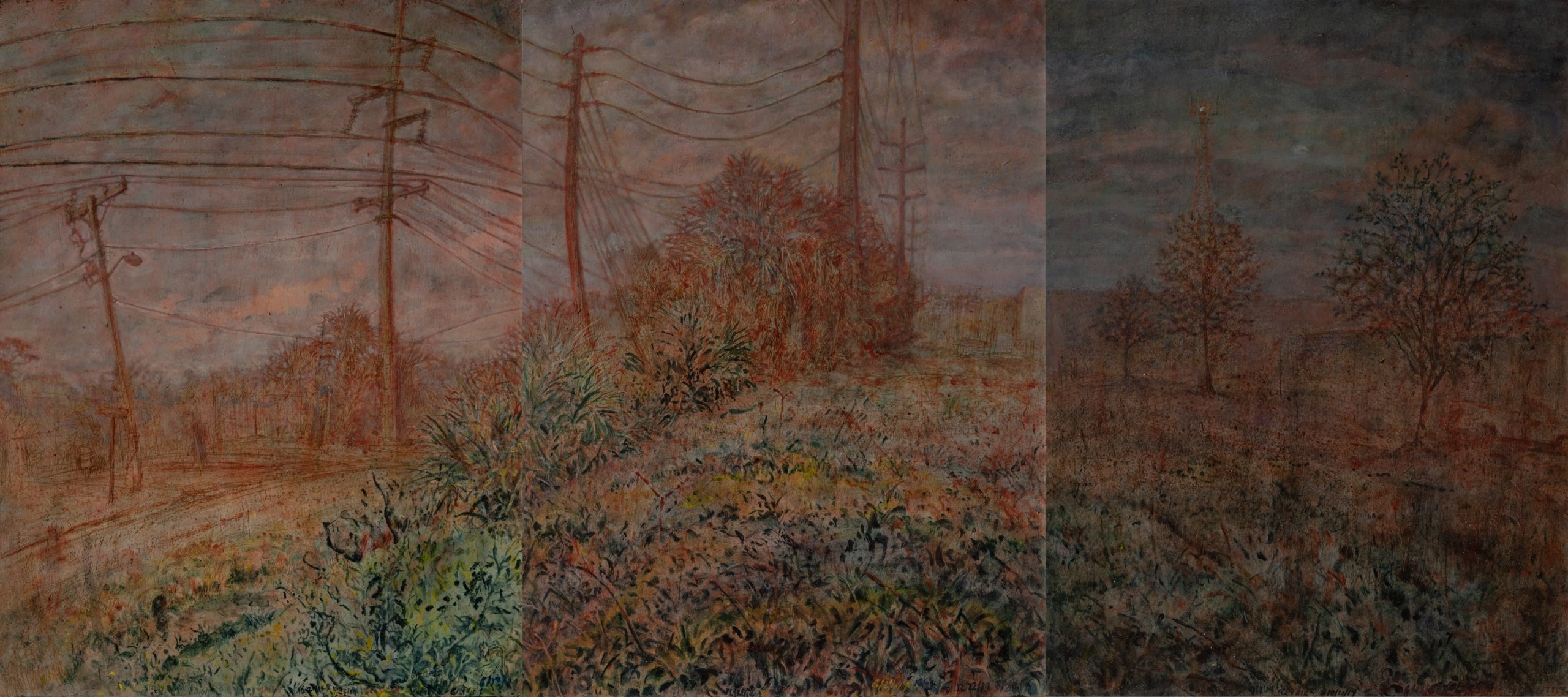
. . .
Both these works are three panel compositions completed en plein air (in open air) in Tarpon Springs. Each takes some inspiration from George Inness (1825-1894) who had a winter studio in Tarpon Springs from 1890-94. Inness was known for his visionary landscapes and his modernist – by 19th Century standards – approach to painting.
The panels demonstrate three pivots from a single vantage point as sundown transitioned to night. At times seasonal conditions, accessibility to sites or technical glitches lead me to re-visit paintings over years. In this case, I worked 2014-15 and then again 2019-20 on this composition.
I painted most of the composition in primary color for its immediacy, form and depth. I find in pleinairism a tension between expressionism and naturalism.
. . .

. . .
I worked on the panels of the painting in standing water. In stages, I would carry all three panels into the cypress dome interior. I rotated the panels while working. Sometimes two at a time, I balanced panels on my lap as I sat on a utility bucket. Between rotations, I used the forms of the swamp – cypress knees and branches of hardwood shrubs – to suspend panels above the water level.
creativepinellas.org/artist/joseph-weinzettle
